Special focus on
Sustainability
Programming dance
Leading arts venues on building audiences
Taking climate action with Julie’s Bicycle
English National Ballet
Reviving Swan Lake in-the-round
Boy Blue’s new production
Kenrick ‘H20’ Sandy MBE in conversation
Zoie Golding MBE
Career longevity in youth dance
one
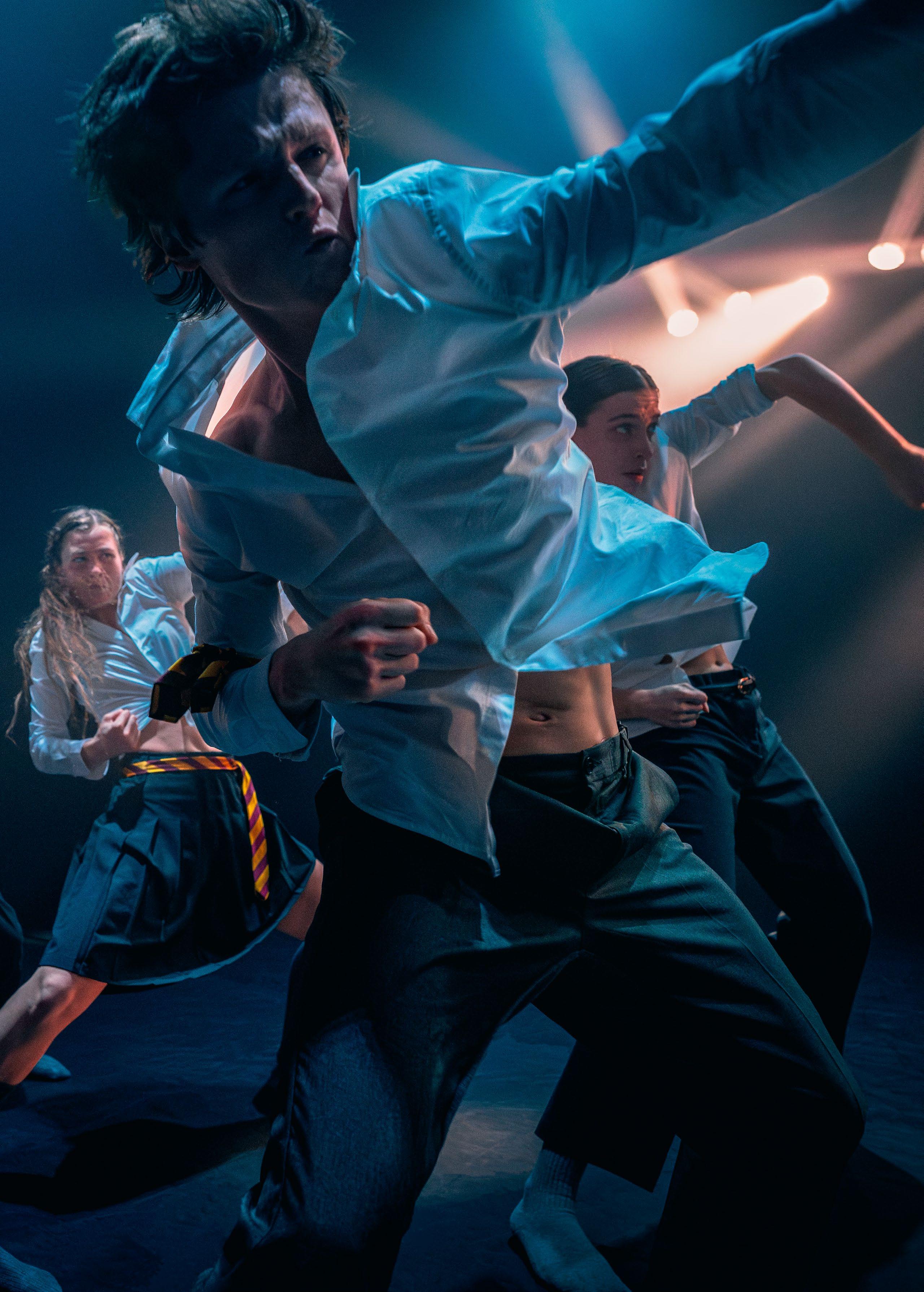

The One Dance UK Magazine Issue 15, Spring 2024


TRINITY LABAN
London’s creative conservatoire
Undergraduate and Postgraduate Dance and Dance Science:
BA (Hons) Contemporary Dance (including Foundation Year options)
BSc (Hons) Dance Science
MA/MFA Choreography
MA/MFA Creative Practice
MA/MFA Dance Leadership and Community Practice
MA/MFA Dance Performance
MSc/MFA Dance Science
Research Degree Programme
Find out more about the right programme for you


#chooseTL
Photo credit: Stephen Berkeley-White @trinitylaban
Start your career in Dance

Special Focus on Sustainability
Welcome
 Andrew Hurst MBE Chief Executive, One Dance UK
Andrew Hurst MBE Chief Executive, One Dance UK
Dear members and friends,
Welcome to this Spring 2024 edition of One which takes a special focus on ‘Sustainability.’ We explore its meaning in many different contexts, including environmental responsibility, managing health, wellbeing and performance, advocating for positive change, and maintaining creativity and a sense of purpose.
I encourage you to read our article on how we can achieve a more sustainable future for dance which (page 12) details how we ensure dance has a voice, and offer meaningful advice on how to encourage change in your own work.
Hear from the team at Julie’s Bicycle on environmentally considerate best practice in dance (page 16), programmers from leading dance venues on sustaining dance audiences (page 36), English National Ballet on reviving its popular Swan Lake in-the-round (page 21), and Boy Blue’s Kenrick ‘H20’ Sandy MBE about Boy Blue’s groundbreaking journey and new production, Cycles (page 18).
Health and wellbeing takes a front seat in this edition too, with articles on neurodiversity in the dance studio (page 30), disability and mental health on stage (page 28) and systematic strategies for improving wellbeing (page 40).
One Dance UK Staff
One Dance UK connects and supports members
Along with receiving free copies of One, the magazine for the UK dance sector, One Dance UK members receive a wide range of benefits, discounts and resources.
For information about One Dance UK Membership or to find out more about how we can support your work, please visit onedanceuk.org/become-a-member or email membership@onedanceuk.org
Andrew Hurst MBE Chief Executive
Cameron Ball Special Projects Manager
Rebecca Bertram Project Manager
Amelia Bickley Membership and Business Development Officer
Dani Bower Marketing and Communications Manager
Lara Coffey Head of Marketing and Communications
Barny Darnell Membership Manager
Paul Hibbert Head of Finance and Operations
Alisha Kadri Head of Membership and Business Development
Jessica Lowe Healthcare Manager, Dance Access Manager
A huge amount of work has gone on behind the scenes at One Dance UK. You may have noticed our brand new website, which helps you connect more easily and meaningfully with our work and that of the wider sector. In February we celebrated outstanding work from across the dance sector at our Awards ceremony, held in Coventry. Congratulations to all nominees, the shortlist, and, of course, the Award recipients, some of whom are featured in this issue.
This summer the U.Dance National Festival heads to Liverpool, with groups selected from thousands of young dancers who recently took part in Regional Platforms nationwide. Alongside the talent on stage and screen, I am always impressed how young people support each other and with their eagerness to try new things. Providing opportunities like this, and lobbying to reverse the decline in arts infrastructure for young people, is essential to sustaining the UK’s worldleading place in the cultural and creative industries on the global stage. As the Subject Association for Dance we work tirelessly to champion dance in schools and ensure our CPD offer helps teachers to upskill and enhance their work.
The One Dance UK team and I look forward to connecting with you in person or online soon.
Board of Trustees
Jo Gatenby Dance in Education Manager
Ríona O'Dowd Marketing and Communications Assistant
Laura Nicholson Head of Children and Young People’s Dance
Chinyere Ogbue Head of Workforce Development
Erin Sanchez Head of National Institute of Dance Medicine and Science, Lead Specialist Health, Wellbeing, and Performance
Chloe Sprackling Marketing and Design Manager (maternity cover)
Katie Stevens Operations Manager
Alan Tuvey Finance Manager
Amy Roberts Education and Training Manager
Amanda Skoog Chair, Executive Director, English National Ballet School
Anthony Bowne Principal, Trinity Laban Conservatoire of Music and Dance
Jane Bonham Carter Baroness Bonham-Carter of Yarnbury, Member, House of Lords
Andrew Carrick Director of Carrickworks
Julian Flitter Partner, Goodman Jones LLP
Victor Fung
Artistic Director and Joint CEO, Pavilion Dance South West
Emma Keith
Managing Director, Digital, National Theatre
Denise Nurse Legal Consultant
Susannah Simons
Arts Strategist and Director of Partnerships, Marquee TV
Patrons
Carlos Acosta CBE
Children and Young People Patron
Peter Badejo OBE
Arlene Phillips CBE
Sir Richard Alston
Champion of U.Dance and Young Creatives
The One Dance UK Magazine | Spring 2024 3
One Dance UK Dance Hub Thorp Street Birmingham B5 4TB onedanceuk.org One Dance UK is a Company Limited by Guarantee. Registered in England and Wales: No. 2931636 Registered Charity: No. 801552 Copyright One Dance UK
A
Photo:
Ayuso
A Sustainable Future for Dance by Andrew Hurst MBE and Baroness Fraser of Craigmaddie
Strengthening our Creative Climate Action by Julie’s Bicycle’s Becky Hazlewood and Sheena Balkwill
18 Cycles of Reinvention by Cameron Ball with Boy Blue’s Kenrick ‘H20’ Sandy MBE
Reviving a Classic with English National Ballet Swan Lake in-the-round's Derek Deane, Adrian van Winkelhof and Lola Stott
A Moment of Movement featuring Akademi’s Suba Subramaniam 26 Creative Exports by Arts Council England’s Cate Canniffe 27 Schechter II: Developing Dancers for Sustainable Careers by Lucy Moelwyn-Hughes
28 Creative Honesty by Chinyere Ogbue with Stuart Waters 30 Neurodiversity in the Studio by Rambert School’s Phaedra Petsilas
Parenthood and Dance by Dr. Angela Pickard 34 Logical Approaches to Youth Dance by Amy Roberts with Zoie Golding MBE 36 Building Dance Audiences by MAC Birmingham’s Deborah Kermode, Theatre Royal Plymouth’s James Mackenzie-Blackman and Southbank Centre’s Aaron Wright
40 Wellbeing for Dancers by Dr. Imogen Aujla
42 Sustainability, Racism and Me by TIRED Movement’s Stacey Green

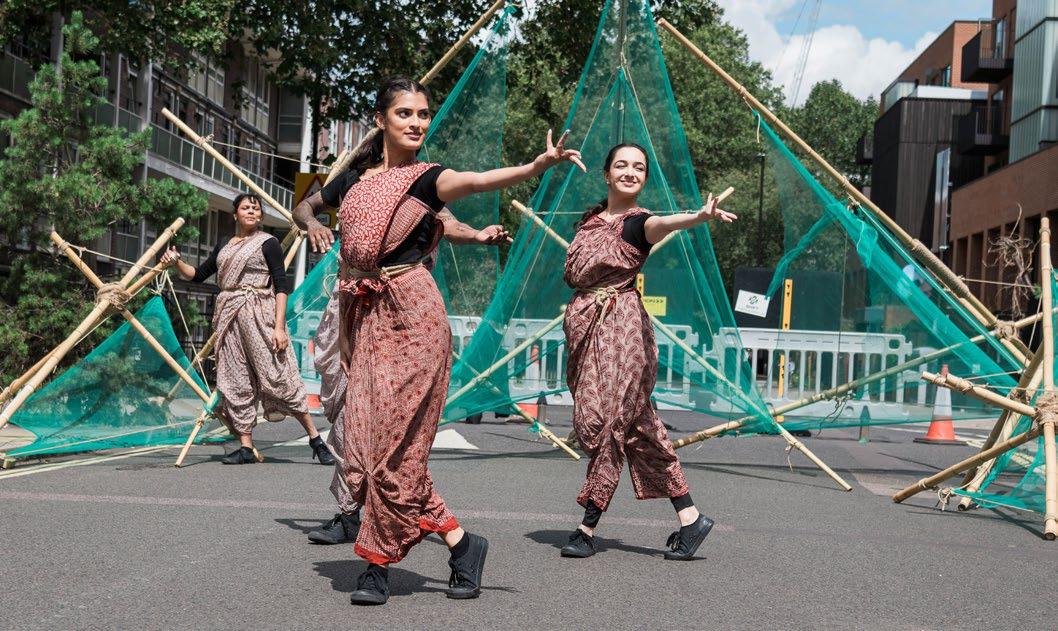
Editorial and Advertising
Lara Coffey
Head of Marketing and Communications
Cameron Ball
Magazine Editor
Chloe Sprackling
Design Manager
Katie Stevens
Assistant Editor
Advertising enquiries
Contact Amelia Bickley amelia.bickley@onedanceuk.org
Funders and Supporters
With thanks to our funder
With thanks to our project partners, funders and supporters.
Design tm-studio.co.uk
Cover image : Schechter II in Hofesh Schechter’s From England with Love, premiering at Southbank Centre, April 2024, and touring. Photo Todd MacDonald. Read more on page 27.
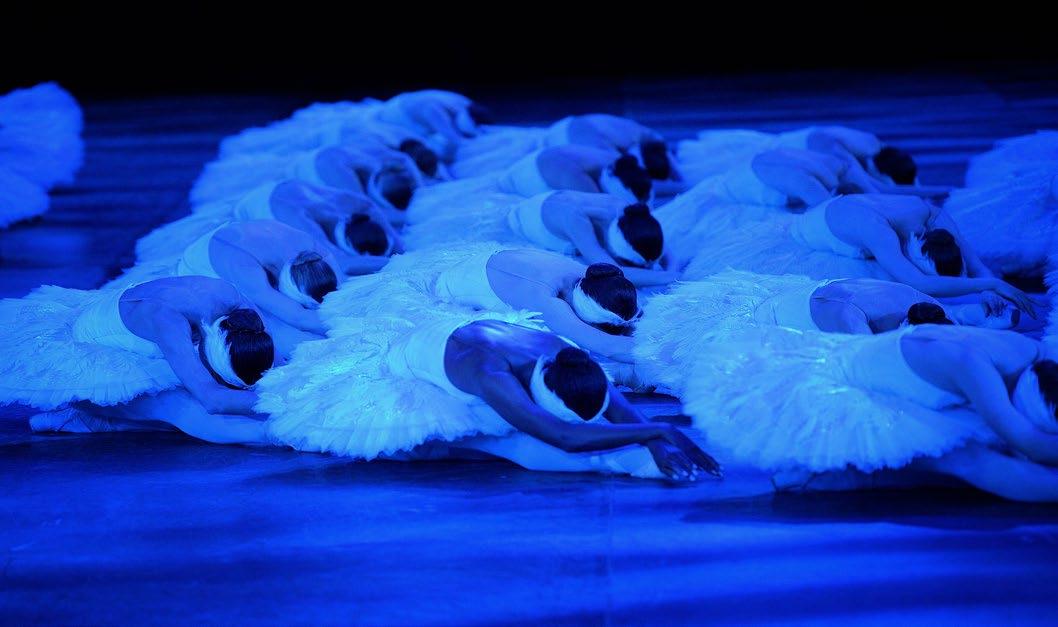
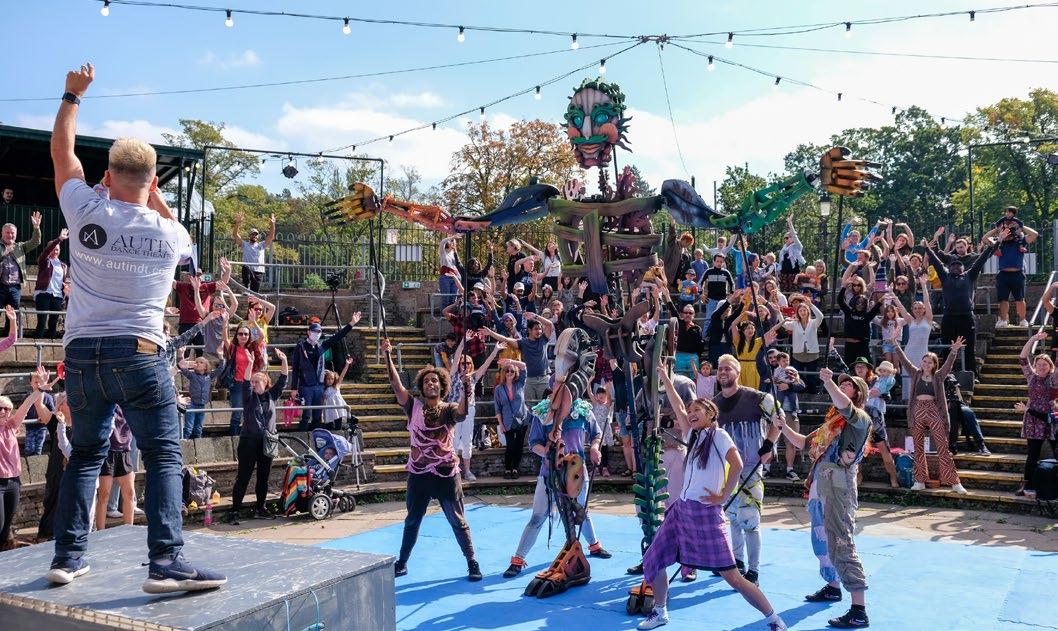
4 The One Dance UK Magazine | Spring 2024 Special Focus on Sustainability Contents In this Issue Introduction 3 Welcome by Andrew Hurst MBE In the Spotlight 6 News 10 One Dance
Special Focus on Sustainability 12
16
UK Membership: Member Q&A with Genevieve Tawiah
21
24
33
One Dance UK Projects 46 U.Dance
44
Page 21
Derek Deane, Choreographer, English National Ballets Swan Lake in-the-round
Page 36
Deborah Kermode, Chief Executive Officer and Artistic Director, MAC Birmingham
Page 24
Suba Subramaniam, Artistic Director, Akademi
Page 18
Photos: Laurent Liotardo, Courtesy Boy Blue, Kate Green & Brian Hartley
Kenrick 'H20' Sandy MBE, Co-Founder and Co-Artistic Director, Boy Blue
WIN TICKETS to the world premiere of Boy Blue’s production of Cycles
Boy Blue presents Cycles at London’s Barbican Centre from 30 April–4 May.
The Olivier award-winning dance theatre company returns with a world premiere that celebrates change and the beauty of perpetual motion.
Cycles is movement at its most fluid, distilled and skilled. Resolute and unapologetic, Boy Blue's latest production is a tenacious exploration of hip hop dance in all its forms. Experience the connection between the movement on stage and the rhythm, groove and bounce of the music, as nine powerful dancers fill the space in what feels like unending motion.
Founded by Michael ‘Mikey J’ Asante and Kenrick ‘H2O’ Sandy, Boy Blue has earned critical acclaim and Olivier Award nominations for its work. They have wowed audiences from New York to Taiwan and recently cocreated the smash hit Free Your Mind in Manchester.
Read more about their new production and approach to their work on page 18.
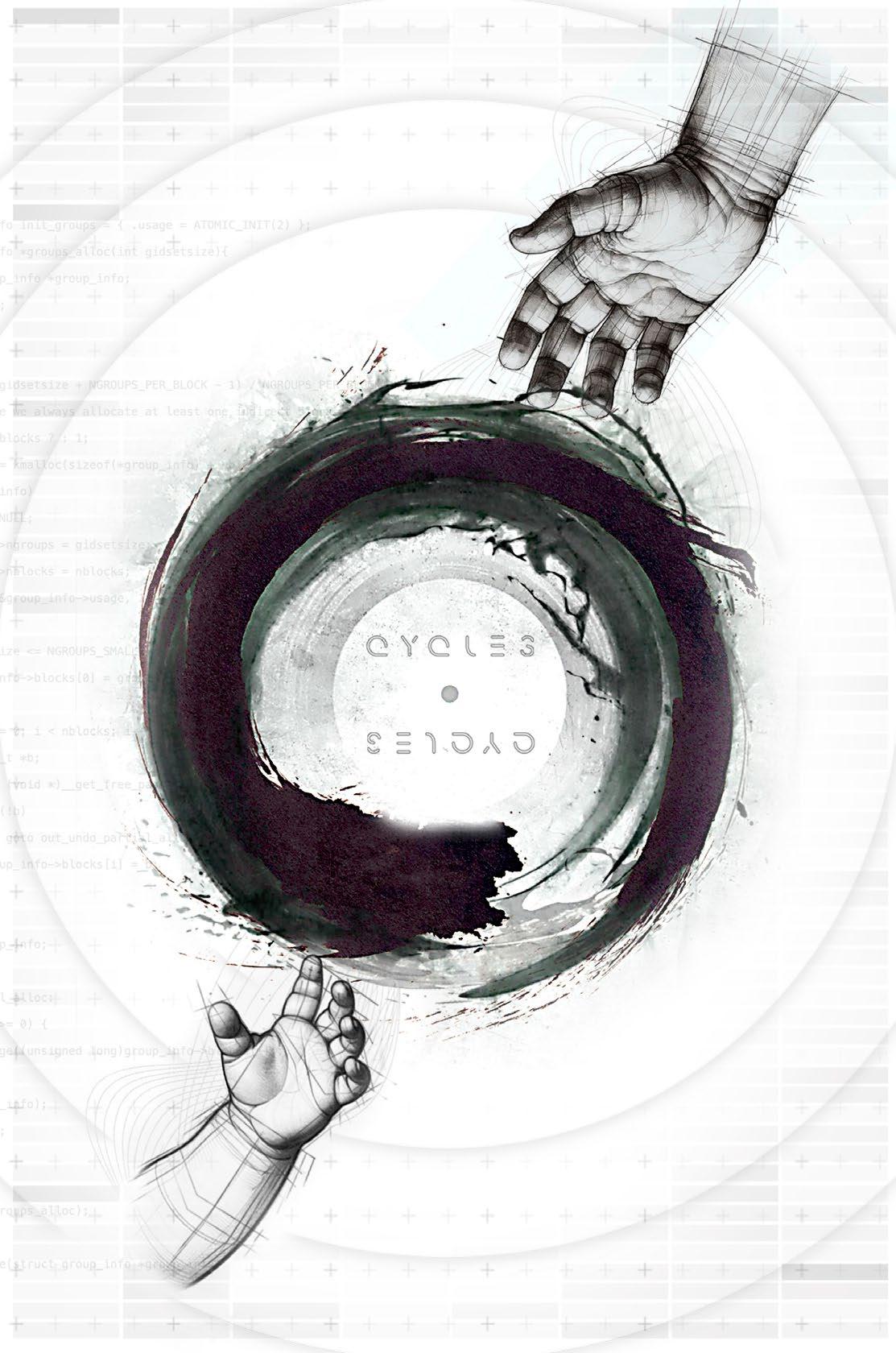
“There are two major energies that I'm really connected with right now. One is the notion of the hip hop dance battle energy of continuous movement. The second energy is the notion of the natural order of life, the organic nature of things, from birth to death, sunrise to sunset. It keeps on going, no matter what is happening in our lives, or what is going on in the world.”
Michael ‘Mikey J’ Asante Co-Founder, Boy Blue
The Prize: We have two pairs of tickets to Cycles on offer to lucky winners, One Dance UK Members receive two entries per submission, doubling your chance to win!
To be in with a chance of winning two tickets to any date of your choice EITHER
Email info@onedanceuk.org with your name and membership number OR
Head to the One Dance UK Facebook or Instagram page (@onedanceuk) and comment on the competition post. Closes 26 April 2024
For further information about the company and the production, go to boyblue.co.uk
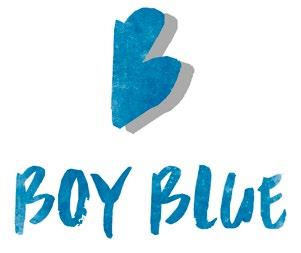
The One Dance UK Magazine | Spring 2024 5 Reader Competition
Terms and conditions apply. Go to onedanceuk.org/terms-and-conditions for details.
News
New National Collaboration to Strengthen Youth Dance in Wales



Three leading dance organisations have marked a significant milestone in Welsh arts through the signing of a memorandum of understanding, in a bid to support the growth of dance in Wales. National Youth Arts Wales, National Dance Company Wales, and Ballet Cymru have joined forces to enable strengthened youth dance engagement and participation across the country. The signing of the memorandum of understanding marks a pivotal moment in the collaborative journey to support and strengthen the dance
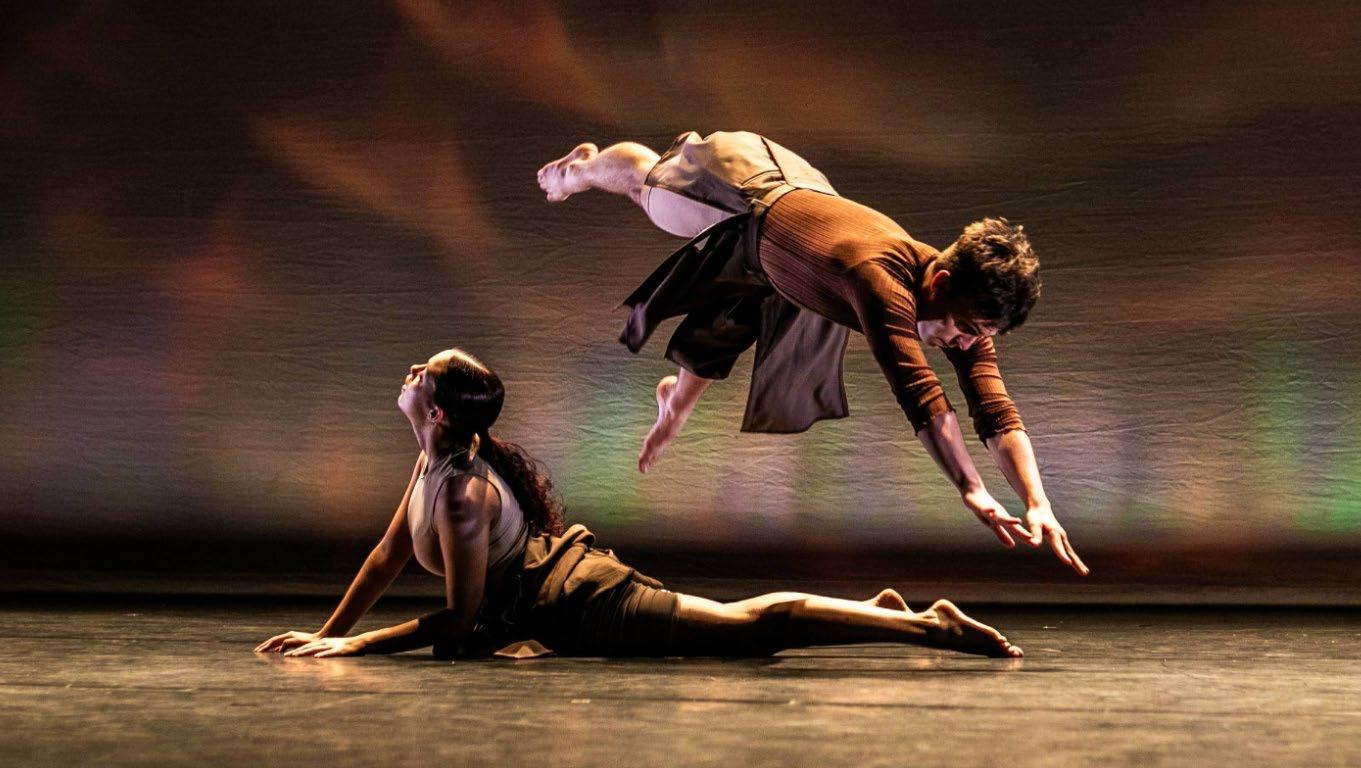
landscape in Wales. With a shared commitment to nurturing talent and fostering inclusivity, the alliance will lay the groundwork for sustainable growth and innovation in youth dance initiatives across the country.
National Youth Dance Wales Producer Jamie Jenkins notes "This new partnership will play a vital role in helping shape the future of youth dance across Wales whilst supporting and celebrating already established youth dance provision. NDCWales, Ballet Cymru and National Youth Arts Wales working closer together is a step in a positive direction."
Remembering Helen Parlor
Helen Parlor, founder and Artistic Director of MÓTUS Dance, is being remembered for her outstanding contribution to dance. Helen impacted so many lives for the better, working with dancers of all ages across her 25-year career. MÓTUS, based in Milton Keynes, has created two initiatives which will celebrate Helen’s achievements and continue her legacy of being a collaborator and champion of dance for all.
In collaboration with Milton Keynes Community Foundation and Milton Keynes City Council, the Helen Parlor Dance Bursary has been established to provide support for dancers and choreographers in Milton Keynes. The 2024 Helen Parlor Dance Bursary will be for £1000. To support their
development, the recipient will also be offered mentoring sessions from their choice of a pool of successful dance artists, choreographers and producers.
On 26 May the dance community will be convening in Milton Keynes to celebrate Helen’s life and vast archive of dance work. A range of incredible professional and local community artists will be sharing their dance works and reflections at a free openair concert at The Rose, Milton Keynes. All are welcome.
The performance will be curated by Helen’s long-time colleagues and friends Kate Taylor and Stuart Waters and will include Motionhouse, Autin Dance Theatre, Pagrav Dance Company and many more. The first recipient of the Helen Parlor Dance Bursary will be announced at the event.
NDCWales Artistic Director, Matthew Robinson said: “National Dance Company Wales seeks to inspire and propel the development of the artists of tomorrow through the work we do on and off stages. As we embark on this strategic collaboration with National Youth Arts Wales and Ballet Cymru our collective ambition for young people fills me with optimism for the future.”
Further information bit.ly/WalesDanceCollab

Further information motusdance.co.uk
6 The One Dance UK Magazine | Spring 2024 Special Focus on Sustainability
Isaac and Layla, NYAW, perform at the U.Dance National Festival 2023
Photos: Brian Slater & the Parlor family
Helen Parlor
Breakin’ Convention 2024 returns to Sadler’s Wells

Created and emceed by UK hip hop maker and Breakin’ Convention Artistic Director Jonzi D, Breakin’ Convention Festival returns to Sadler’s Wells in Islington to celebrate hip hop culture in all its forms over the Early May Bank Holiday.
The Festival showcases international acts from the USA, South Korea and France, as well as performances from local and national talents on Sadler’s Wells stages. Performances, activities
Let’s Dance International Frontiers 2024 Camouflage: Embodied Dance
Let’s Dance International Frontiers (LDIF) is an annual dance festival launching each year on 29 April, International Dance Day. With dance at the heart, LDIF pushes boundaries with a creative programme that reflects the international nature of Leicester through performances, discussion seminars, masterclasses and an annual conference. Over the last fourteen years, LDIF has presented over 280 artists and companies, including 69 UK premieres and 42 world premieres.
Let’s Dance International Frontiers 2024 (LDIF24) explores the theme of Camouflage: Embodied Dance. The theme is a deceptively simple premise
for children of all ages, live DJ sessions, dance and bespoke graffiti workshops, freestyle sessions and shows take over the entire building.
From 6pm on Saturday 4 & Sunday 5 May, audiences will be able to see performances from some of the world’s leading hip hop acts including: Femme Fatale (USA), Sons of Wind (France) and Jinjocrew (South Korea), CREATE4 (Netherlands) and Ekleido (UK), Ivan Michael Blackstock’s company TRAPLORD (UK), Boy
that opens the door to a realm of Black theorists, from Édouard Glissant’s “right to opacity” to the paradox of the invisibility/hyper-visibility of Black women discussed by bell hooks and many others, through to the socio-political commentary of Caribbean carnival and Mas reflected through the camouflage of oneself. Ultimately, the premise tackles issues of the Black performing body, the histories embodied within and the transformation of a dance artist sharing these stories.
Attendees of LDIF 2024 can expect masterclasses, panel discussions, networking events and performance from leading UK and international artists including Raul Reinoso/Acosta Danza, L’Antoinette Stines, Clemence Oliver, BlakBrik and many more.
Blue (UK), When Time Was New (UK), Gully South Block (GSB)(UK), Company DHW (UK), Sasha Mahfouz Shadid (UK) and ShaolinOrShao (UK) – plus a solo by Jamal Sterrett (UK). During the interval, Cie Kilaï (France) performs in the Lilian Baylis Studio.
The Festival’s programme displays a wide variety of hip hop styles including breaking, popping, krumping, threading, funk and bruk up.
2024 is a significant year for breaking as it becomes an official Olympic sport for the first time at the Paris Olympics this summer. Academy Breakin’ Convention will open at Sadler’s Wells East, offering a full-time further education programme for 16 to 19-year-olds that includes training in all aspects of hip hop – the first of its kind. Academy Breakin’ Convention will have a stall at the Festival on both days, where audiences can find out more about the course, and will host auditions on Sunday 5 May.
Further information sadlerswells.com academybreakinconvention.com Further information 29 April-4 May, Leicester. serendipity-uk.com
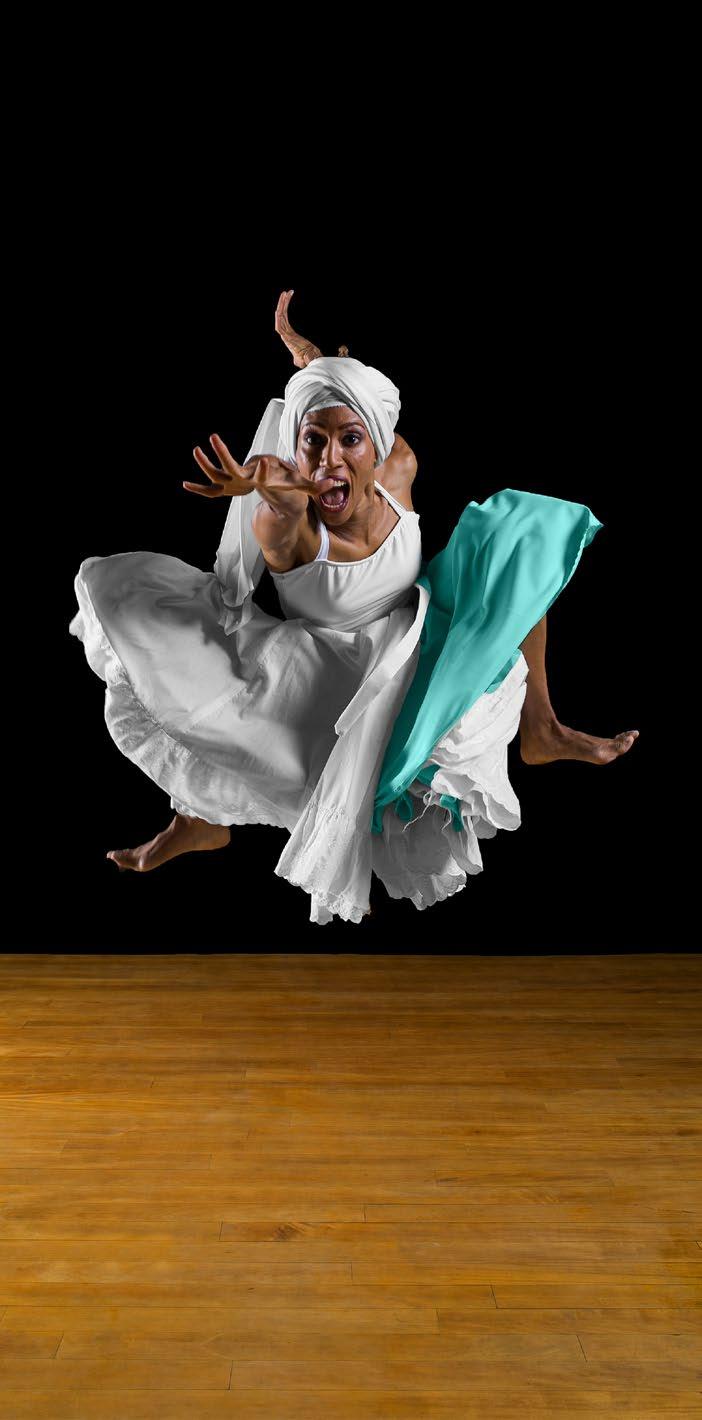
The One Dance UK Magazine | Spring 2024 7 Special Focus on Sustainability
News
Photos: Belinda Lawley & Jamie Barnett Photography
LDIF - Kerry-Ann Henry in Chris Walker's Mountain Climbing
Breakin Convention – Gully South Block, Breakin' Convention 2023
One Dance UK Awards
The One Dance UK Awards aim to celebrate, acknowledge and reward the people who have made an impact on the vibrant UK dance landscape!
The Awards took place in February at The Box, Coventry. and were hosted by Coventry’s Poet Laureate John Bernard. Audiences saw performances from Motionhouse, Ankura Dance and BreakDots Ltd and a panel discussion on supporting dance freelancers with C-Dare, Lakshmi Srivasan, Ascension Dance and Mercurial Dance.
View the One Dance UK Awards Recipients here:

Congratulations to all recipients and nominees!
With thanks to the One Dance UK Awards 2024 Silver Sponsor:

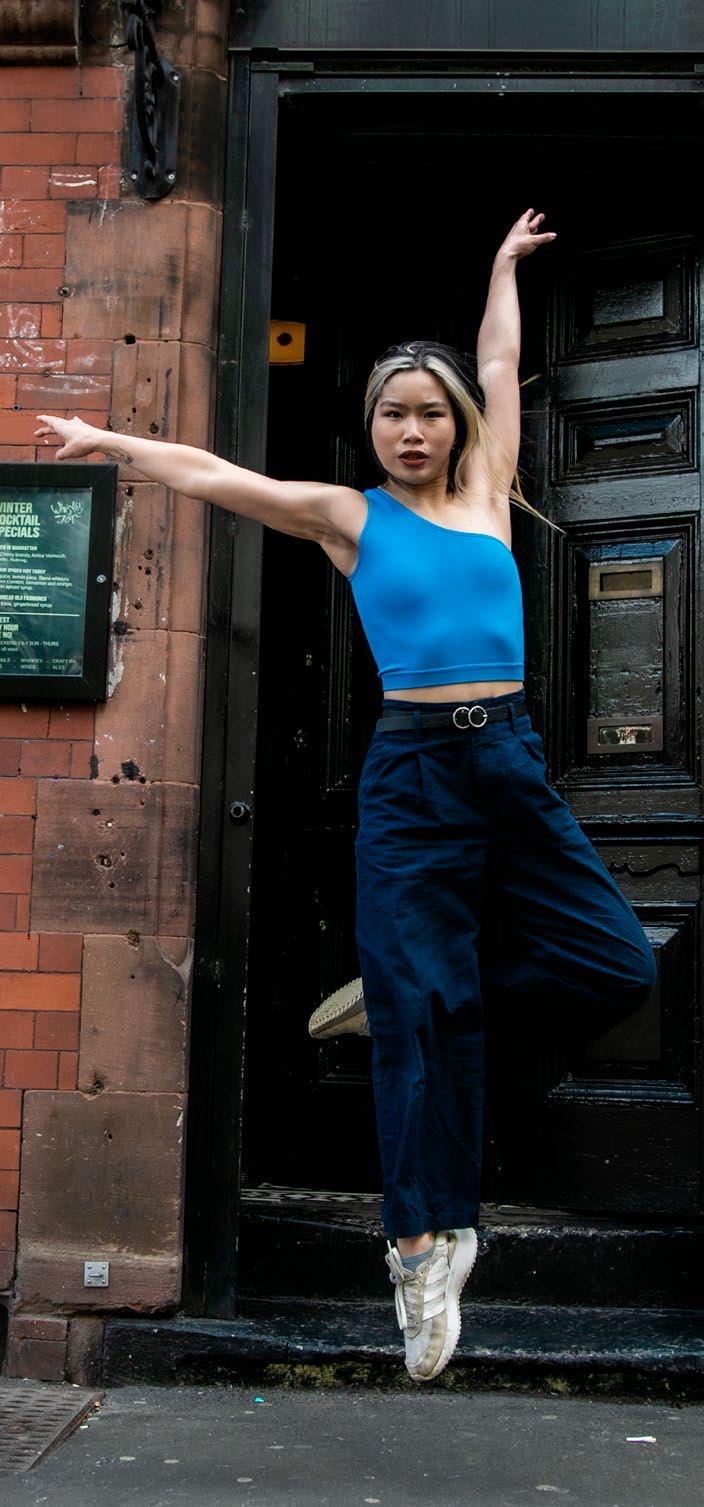
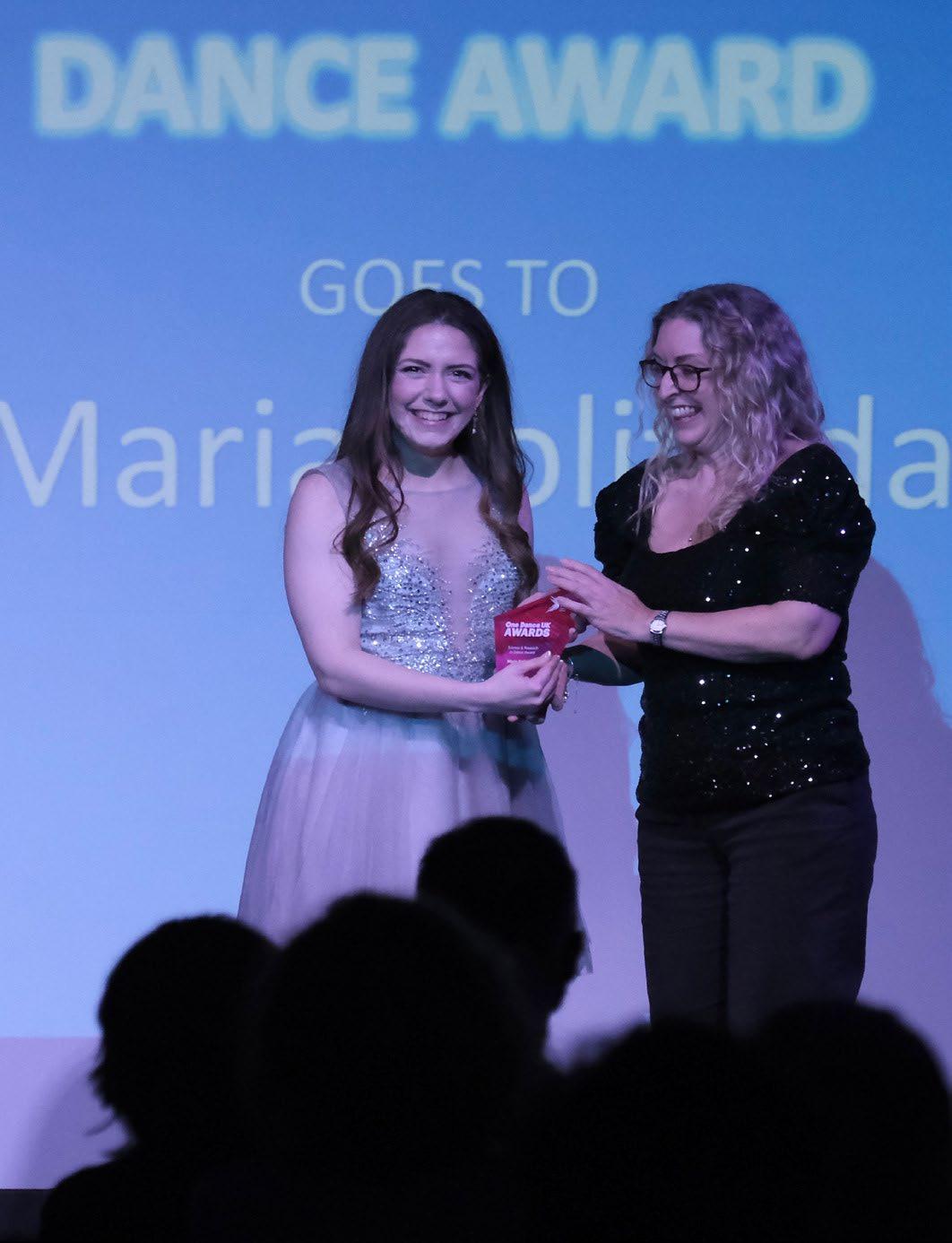
Reach the UK dance sector
One Dance UK connects sponsors and advertisers with a diverse audience of venues, artists, freelancers, teachers, organisations, healthcare practitioners, dance scientists, students and professionals in the UK. Share your brand across our digital and print platforms as well as in-person programmes.
As a programme sponsor or advertiser, you can deepen engagement with our dance community, including members and programme beneficiaries.
One Dance UK is committed to the wellbeing of the dance ecology; protecting dancers’ health and future career prospects. We invite sponsors, who share similar values, to further our mission as well as continue protecting the welfare of dancers and the wider community.
We offer a range of sponsorship opportunities; from in-person events to bespoke digital advertising campaigns.
Exclusive advertising rates are available to members of One Dance UK.
Further information and connect with the team: 11 Awards 31 Shortlisted Nominees 400 Nominations 1800 Public Votes

One Dance UK Awards Photos: Point Of View Photography and Dani Bower
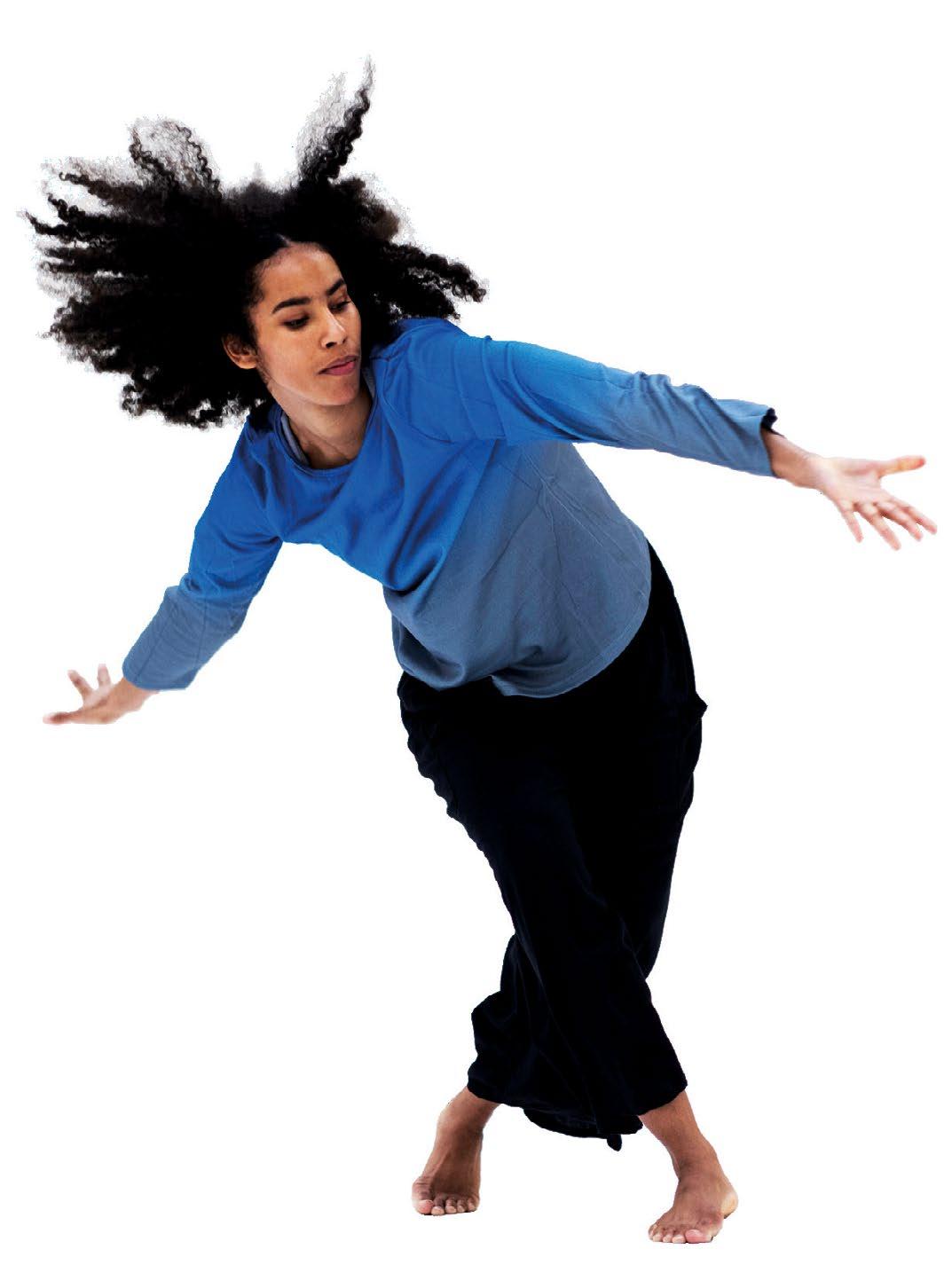





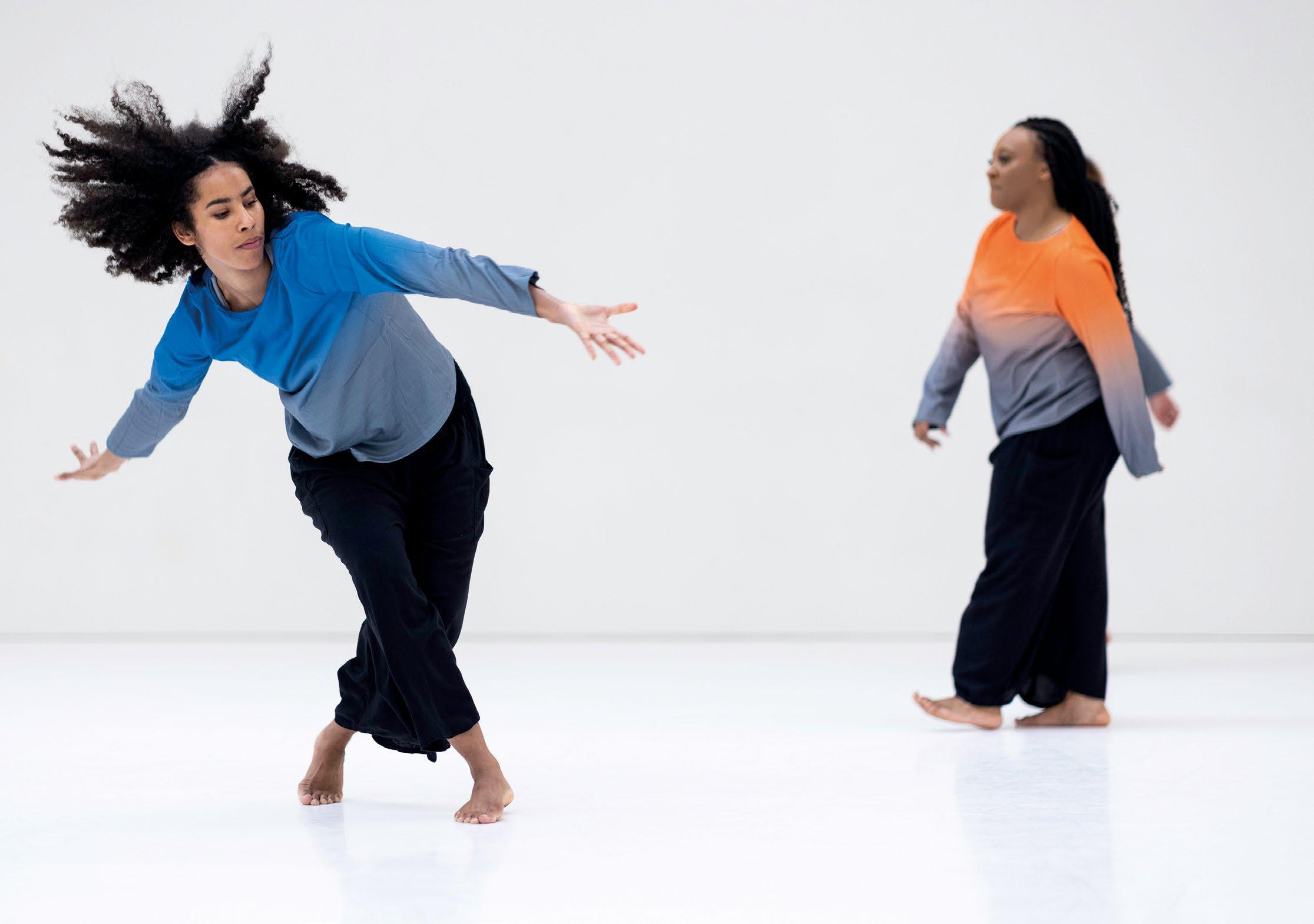
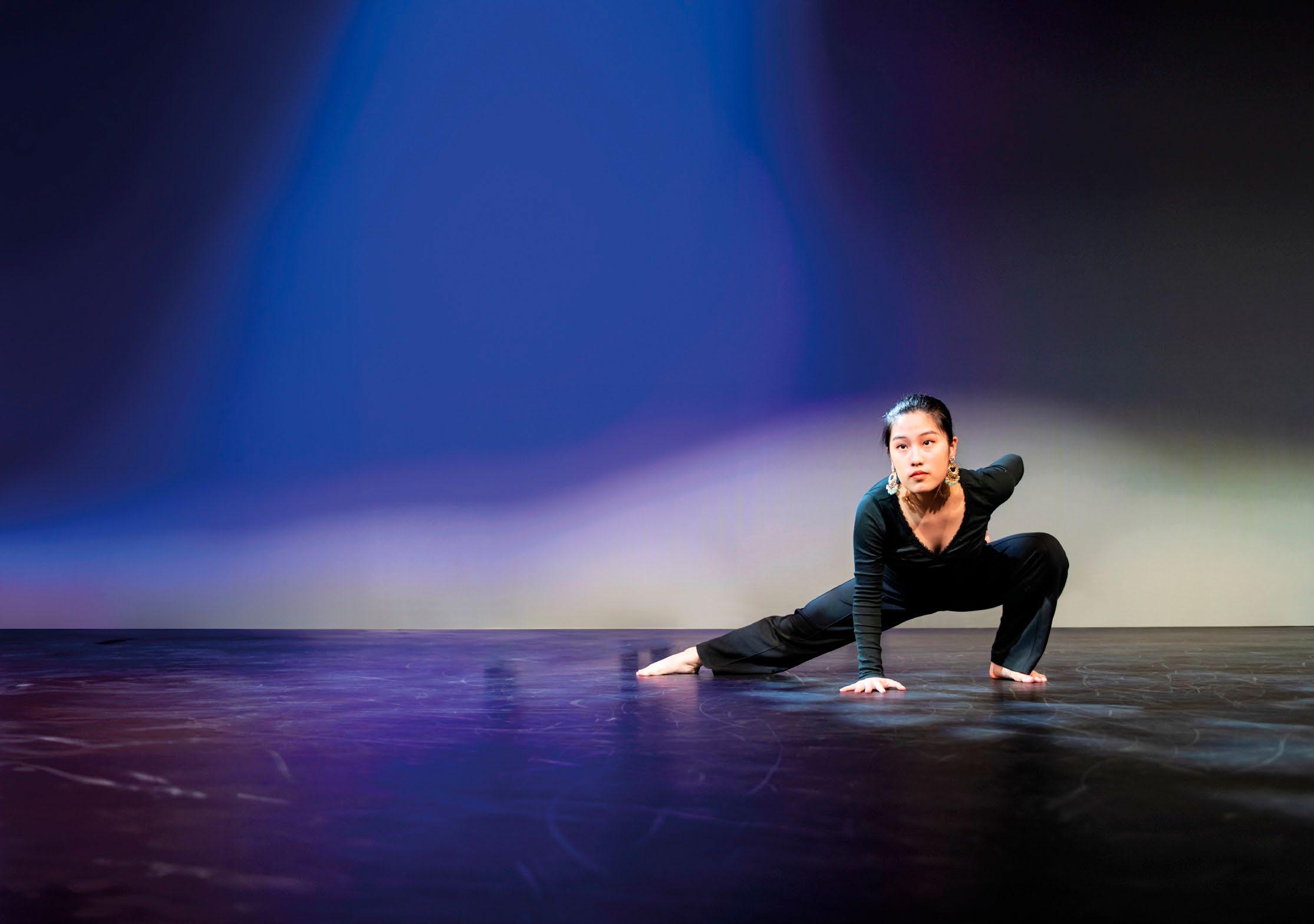
The One Dance UK Magazine | Spring 2024 9 Learn to Teach Our programmes are designed to meet your aspirations and reflect our international reputation for excellence in dance teacher education. • BA (Hons) Ballet Education • BA (Hons) Dance Education • MA in Education (Dance Teaching) • Certificate in Dance Teaching (Ballet) • Licentiate of the Royal Academy of Dance
Professional Dancers’ Graduate Teaching Diploma Find out more radprospectus.info Email: faculty@rad.org.uk Tel: +44 (0)20 7326 8086 LEARN / TEACH / DANCE Royal Academy of Dance® is a charity registered in England and Wales No. 312826. Photo by Tim Cross 10495 One dance ad Jan 24 draft 2.indd 1 29/01/2024 19:18 A flexible low residency programme designed to support artists working within a diverse range of dance styles and contexts. Join our professional Hub – share, shape and define your practice with IRIE! dance theatre. New MA Diasporic
Styles Course enquiries: www.iriedancetheatre.org | e: MA@iriedancetheatre.org | t: 0208 6916099 Validated
•
Dance
by Goldsmiths, University of London
Meet a Member
In our series of Q&As with members, Membership Manager Barny Darnell caught up with Healthcare Practitioners Directory member Genevieve Tawiah, a chartered physiotherapist.
Genevieve has a particular interest in the performing arts, working with dancers to advise on strategies to prevent injury, support recovery, and maintain their physical health whilst performing.

1. What are you up to currently?
I'm working in a clinic in London at Complete Physio and popping up elsewhere upon request. I’m also writing an article (which is new for me!) which I’ll be sharing later this year. I'm hoping to collaborate with more performing arts schools, and will be looking after Strictly Come Dancing artists again with my colleagues at ‘P-rehab UK’ later this year.
I’ve otherwise been mapping out projects I want to be part of and people I'm keen to work with, in manifesting mode.
2. What are your first memories of dancing?
My family are generally music lovers so I'm sure I was dancing about before, but my first proper memories of dance were back at the first dance school I went to. The purple leotards, the crazy show outfits, me absolutely loving tap dancing.
3. What advice would you give to someone hoping to start a career in dance?
Train your weaknesses, in dance and in body. Spending time with things you're not good at or areas that aren't
strong can feel uncomfortable, but can reap rewards in confidence and in performance.
Though you'll spend a lot of time in rooms being compared to other people when you train or audition, know that you are different to them and so your needs will differ too. You may need to warm up or train differently to achieve what outwardly looks like the same result.
4. What’s a common misconception about dancers?
That they'll work for free. These are expensive times, so it’s unfair and hard to justify jobs that ask dancers to come just for exposure.
When you book dancers for a job, payment will go towards them keeping themselves well, managing any injuries, feeding themselves well, getting suitable accommodation and more. It's a representation of the work they've done to get there too and beyond the work they do in the studio.
“Dancers are athletes. And should be treated like they are.”
5. What concerns you most about the future of dance in the UK?
We've seen it increasingly since the pandemic, but funding for the creative sector seems to be getting even tighter. We see training or performance spaces struggling to survive and rising prices making it
more difficult for people to access training that could help their dance development or give them the space to develop their ideas, particularly underprivileged groups.
6. Why did you join One Dance UK as a member?
I think One Dance UK is a fab community and resource for dancers and individuals working with dancers. The Healthcare Pracititioners Directory is great for signposting, development opportunities and it also helps for dancers to see that I’m actively working with other dancers!
7. How does dancing help you in your life?
Dancing is my number one outlet, and it has been for a lifetime. It’s a place I can pretty consistently switch off out of the world and just be. It’s often a mood lifter or a supply of energy to do the rest of the day as I choose. It’s what connects me back to me.
8. This edition focuses on Sustainability. In your field you no doubt have worked with many dancers to sustain their bodies through rigorous schedules. What do you enjoy about your work?
I love that I get to work with people who utilise their bodies to express their art, and that I can try to facilitate their journey of producing that art and often witness the end result. That to me is just beyond.
10 The One Dance UK Magazine | Spring 2024 Special Focus on Sustainability
Melanie Gail Photography
Genevieve Tawiah
Photo:
Special Focus on Sustainability
9. What are some simple tools you recommend dance artists use to sustain their physical condition?
Take time to look inwards. Body scans can give you a moment to try and translate the information your body is giving you, so you can do something about it.
Train differently. Set yourself up well: consider implementing strength training separately; add in Reformer Pilates for control or other strategies; and don't forget that part of your training schedule is to rest.
Fuel yourself well. Your diet needs will change as your activity does. Stodgy snacks won’t leave you feeling good when you are busy. Meal prep - source well if you’re buying on the go; make time to sit down and eat properly.
10. Finally, if you could have one last dance, what would that be? I'm keenly working on my freestyle and I've been to some really cool freestyle movement spaces that encourage individuality in movement, led by Vikki Clark, ‘Tali’ Fergus and Kloe Dean to name a few.
It would easily be one of these. Dancing in a supportive space, in a room full of people who love to move.
tawiahphysio.co.uk @tawiahphysio

One Dance UK’s Healthcare Practitioners Directory
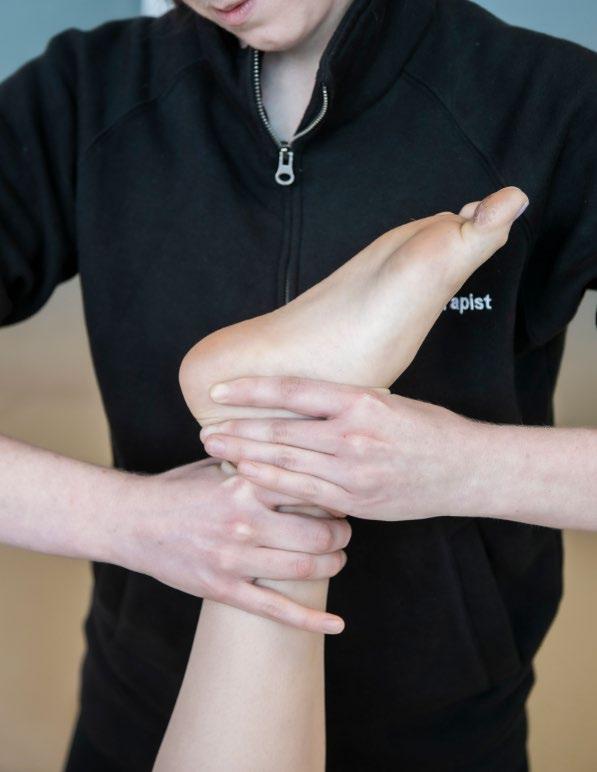
The Healthcare Practitioners Directory is a free searchable online database listing details of medical, psychological, and complementary health practitioners throughout the UK. All the individuals on the directory have been recommended by members of the dance profession.
Are you a qualified healthcare practitioner? Join us as a member! onedanceuk.org/become-a-member
Would you like healthcare support?
See the directory here: bit.ly/HP-Directory
The One Dance UK Magazine | Spring 2024 11
Photos: Tawiah Physio & Dani Bower for One Dance UK
Genevieve Tawiah treats a client

A sustainable future for dance
by Andrew Hurst MBE and Baroness Fraser of Craigmaddie

Since One Dance UK came into existence on 1 April 2016, dance in the UK has seen a lot of change, and faces some very real challenges to its survival and sustainability going forward.
One Dance UK itself has faced an enormous amount of change too, and we continue to learn and evolve to ensure we remain responsive to your needs and provide the support the dance sector needs to survive and thrive.
The UK dance sector is an international success story and the envy of many of our international partners, but our vision at One Dance UK is for an even stronger, more vibrant and more diverse dance sector. Our overarching aim is to empower the dance sector workforce to be connected, unified, highlyvalued and sustainable. This informs our mission to provide
the information, training, resources and opportunities needed to ensure the dance workforce is well-equipped to secure dance’s prominence in the cultural landscape of the future, and to champion excellence across the sector. Hopefully you will see some of this reflected over the coming pages and in everything we do to support and connect you.
“Representatives from across all of the performing arts should make it as easy as possible for Government to know what needs to be done, to understand the full implications of their actions, whilst also organising ourselves as a sector to recognise and take advantage of opportunities as they arise.”
Baroness Fraser of Craigmaddie, Co-Chair, APPDG
12 The One Dance UK Magazine | Spring 2024
Photos: Chloowe, Martha and Dance Transports by Dani Bower.
Special Focus on Sustainability
How do we work with politicians and civil servants? And what is the impact?
Through our work with the Government and policymakers, we make sure your needs are understood and represented at the highest level when policy is being developed and decisions are being made that will impact our artform. We have worked hard over the past 8 years to build strong positive relationships and are now able to work closely with government and officials as trusted partners. This is perhaps the greatest success of the merger which formed One Dance UK and is where the real strength and value lies in bringing together members working in dance across a range of different contexts and across all corners of the UK.

“Life for the performing arts remains extremely challenging as the COVID-19 pandemic continues to impact all our lives in many different ways, economically, socially and in terms of health and wellbeing… the effects of [the pandemic], the impact of the restrictions, the substantial rise in anxiety levels and fear of being in crowded spaces, is still having a significant impact on behaviours today… [we] need to improve resilience and preparedness for a volatile and uncertain future. This is something the performing arts instinctively know and understand as the ability of the sector to adapt and problemsolve is, I believe, one of its greatest strengths.”
Baroness Fraser of Craigmaddie, Co-Chair, All-Party Parliamentary Dance Group
As a result of our briefings the UK-EU Parliamentary Partnership Alliance wrote to the Home Secretary and the Partnership Council highlighting the ongoing disproportionate impact of Brexit on young and less experienced artists, urging them to prioritise the mobility of touring artists, with a view to developing a comprehensive approach that would allow artists and their teams to tour freely in the EU and UK - potentially as part of the forthcoming Trade and Cooperation Agreement Review (recommendations 15 and 22 to the Partnership Council in December 2023)
We are now able to raise specific issues that impact the way you work day-to-day (like visa delays, the claiming of tax reliefs, or the issuing of A1 Social Security needed forms for international touring) with the relevant government departments to ensure delays are addressed and issues are resolved.
We represent the sector and your needs through our participation in various committees and working groups like the Cultural
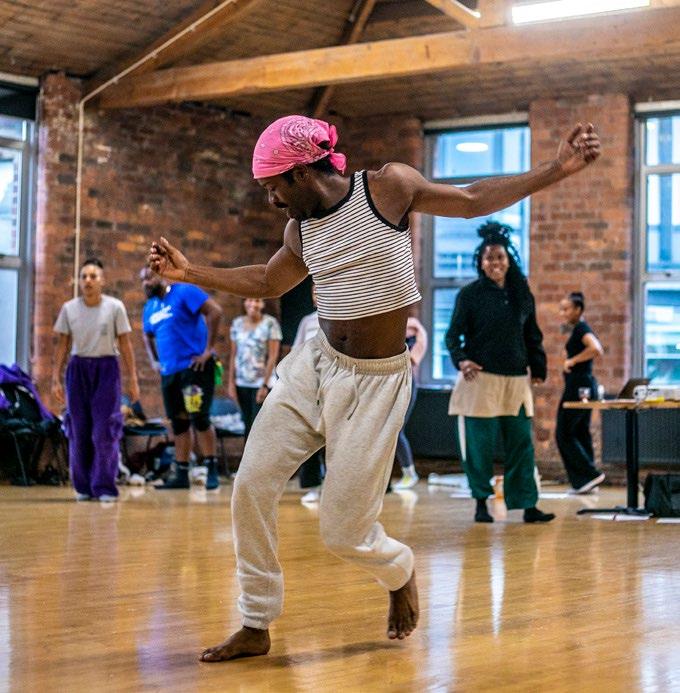
Recovery Task Force through the pandemic, and the Task and Finish group currently creating an action plan to address the recommendations for the Creative Industries from the Good Work Review. We are also part of the Department for Education’s Out of School (OOSS) Steering group.
We speak to parliamentarians directly and provide the secretariat for the All-Party Parliamentary Dance Group (APPDG), taking guest speakers and key dance sector representatives into the heart of parliament so MPs, Peers and officials can hear about the issues that matter to you most directly from you, in your own words. The Officers and Members of the APPDG are drawn from across all parties, and both Houses and with your help become passionate advocates for dance in the UK,
The One Dance UK Magazine | Spring 2024 13
Special Focus on Sustainability The One Dance UK Magazine | Spring 2024
and key allies in addressing the issues which impact your work the most.
We provide policy notes and briefings for members of both the Commons and the Lords so that they can raise parliamentary questions on our behalf, challenge existing or new policy passing into law, and contribute to important debates in both Houses with accurate sectorspecific and up to date knowledge like for the most recent EU-UK Parliamentary Partnership Alliance meeting last December, and for the Shadow DCMS and Education teams ahead of the recent Labour Creatives Conference. One Dance UK provides the secretariat for the Programme Board: Children and Young People’s Dance, which brings together all organisations with
a strategic remit for dance education and training in England, including DfE and Arts Council England. We work hard to always put your needs at the centre of everything we do and provide the support you need to champion best practice and promote positive change in the dance sector.
Increasingly we are working more closely with other Creative Sector bodies to align messaging and policy priorities. Together we are calling on the incoming government to: ensure every child and young person has access to high quality dance education and training as part of a truly broad and balanced curriculum; review and reform the Progress 8 and EBacc accountability measures for schools in England; protect

the talent pipeline and touring post-Brexit; champion the value of the dance sector at home and abroad; and recognise the contribution dance makes on the health and wellbeing of the nation.
A policy paper from the Save Our Subjects partners (One Dance UK, the Incorporated Society of Musicians, and the National Society for Education in Art and Design who are all Subject Associations) provided key information that featured in Sir Keir Starmer’s speech at the Labour Creatives Conference with a commitment from Labour to review progress measures as soon as they enter government.
“[When] Churchill was asked to cut funding to the arts in order to support the war effort in World War II, he [allegedly] responded ‘Then what would we be fighting for?’ Even if he didn’t say this, he is recorded as saying in 1938,‘The arts are essential to any complete national life. The State owes it to itself to sustain and encourage them.’In that case, we, the representatives and supporters of the performing arts, must ensure we remain as united and resilient as we can in order to hold the State to account for this.”
Baroness Fraser of Craigmaddie, Co-Chair, All-Party Parliamentary Dance Group
14 The One Dance UK Magazine | Spring 2024
Photos: Linden Dance and Aishani Ghosh by Dani Bower. Special Focus on Sustainability
What can you do to make a difference?
We rely on you, our members, and the sector more broadly to work with us to develop the strongest possible evidencebased arguments for continued and increased investment in dance. We will need to work even more closely together to do this going forward, to bolster resilience and safeguard our artform for future generations.
With a general election fast approaching, how government policy affects us all is at the front of people’s minds and being hotly debated, but what can you actually do that can make a difference?
There are three key things you can do:
1. We often get asked for data on the dance sector at short notice, and so the first thing you can do to help is to respond to requests from us for information (short polls, or surveys) and share any relevant stats and stories on your work and the impact of dance on the UK population in order to help us present the strongest possible evidence-based arguments for investment in dance.
2.
We work hard to ensure dance is part of the conversation, and that your needs and the impact of policy on your work are clear and understood across government and officials but you can also do this yourself, helping to get dance on the political agenda by raising key policy issues with candidates campaigning for the local or general elections, and by writing to your local MP about dance in your constituency and any issues that affect your work. As a constituent they effectively work for you, and it’s their job to listen and respond to your needs.
3.
You can also write to your MP to ask them to become a member of the APPDG which will ensure they are fully informed of the issues affecting you, as a constituent, and someone who is passionate about the importance and impact of dance. You might express to them how becoming a member would be a valuable declaration of commitment to the importance of dance in the UK. It might be helpful to highlight dance organisations or activity in the constituency, especially if you are able to include details like the number of schools or young people engaged in dance, or the proportion of voters engaged in dance activity. We share invitations from members for the APPDG to attend events and performances so they can see, get to know, and speak to dancers and dance professionals in person to learn about their work first hand, so you can also let us know if you have an event or performance you are able to host the APPDG at, so we can invite them to join us there. You can of course write to your MP to invite them personally to come along too.

One Dance UK was involved extensively in consultations around the Cultural Education Plan, both directly and by hosting listening exercises with key stakeholders. The Plan was due to be published by the end of 2023, but has not yet been released. Once published, we will be providing a summary of recent key policy developments and hosting facilitated roundtable sessions so you can get involved in shaping policy asks for dance in response, which we aim to use in an update to the Dance Manifesto ahead of the General Election. Look out for further details on this.
Work with us to make sure your voice is heard, because we exist to amplify your voice.
Quotes from Baroness Fraser are taken from a keynote speech at the recent launch of research entitled “Resilient Stages: Live Performing Arts and Crisis Policy after Covid-19” comparing pandemic responses across the G7 countries, with her permission. Our thanks to her and the rest of the APPDG for their ongoing support.
The One Dance UK Magazine | Spring 2024 15
The One Dance UK Magazine | Spring 2024
Special Focus on Sustainability
Strengthening our Creative Climate Action
Julie’s Bicycle has partnered with over 2000 organisations in the UK and internationally to act on climate, nature and justice crises. Becky Hazlewood and Sheena Balkwill share innovative examples of best practice and useful advice on how dance artists and organisations can create incredible dance experiences in sustainable ways.
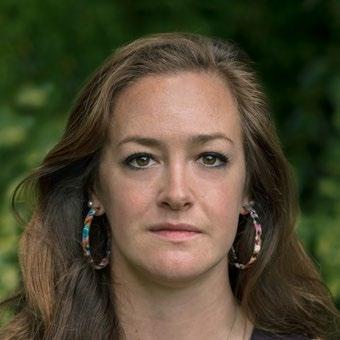

Culture is a powerful force. It touches hearts and minds, inspiring action and helping us to understand climate change through expression, creativity, storytelling and shared experiences. With news that the world has breached 1.5 degrees of warming for an entire year, the need to accelerate our collective efforts has never been more urgent.
Dance companies, venues, artists and choreographers are stepping up and responding in practical and creative ways, engaging their staff, audiences and communities. They are adjusting how they work, the stories they tell, and the impact they make. Our team at Julie’s Bicycle are privileged to partner with and support exciting projects that showcase how the dance community is taking creative climate action.
The Act Green report by Indigo states that 87% of cultural audiences worry about the climate crisis, and 77% think cultural organisations have a responsibility to influence society to make radical change in response to the climate emergency.
Weaving environmental themes into the narrative of performances leaves a lasting impact on audiences and we can share some great examples from across the sector. Balbir Singh
Dance Company’s The Boy with the Rollerblades gently introduced environmental themes to children and families with a story about melting polar ice, featuring encounters with endangered species and everchanging weather. Corey Baker Dance’s Blown was shown to coincide with COP26 global climate conference in Glasgow. Inspired by renewable energy and the power of the wind, segments of the work were filmed on Greenpeace’s ship, Rainbow Warrior, in the waters of Europe’s largest offshore wind farm.
Further inspiring examples of narratives centring nature and our place in it include: Yorkshire Dance’s The Land We Are, Vanessa Grasse’s project encouraging audiences to revive our connection with and care for nature; Rosemary Lee and Roswitha Chesher’s Orchard Portraits video installation shown by Arts Admin featuring senior performers and school children moving alongside and amongst aged trees; and South East Dance’s Our City Dances at a Glance festival celebrating nature and wellbeing.
A practical way to take climate action is reducing energy emissions. Marlowe Theatre Canterbury’s solar panels have powered the equivalent
“Environmental responsibility has become incredibly important for Dance
Consortium and our member theatres. Our approach to sustainable touring is embedded in our strategic plan and we share green initiatives with staff, participants and audiences across the country to help drive change.”
Joe Bates, Executive Director, Dance Consortium
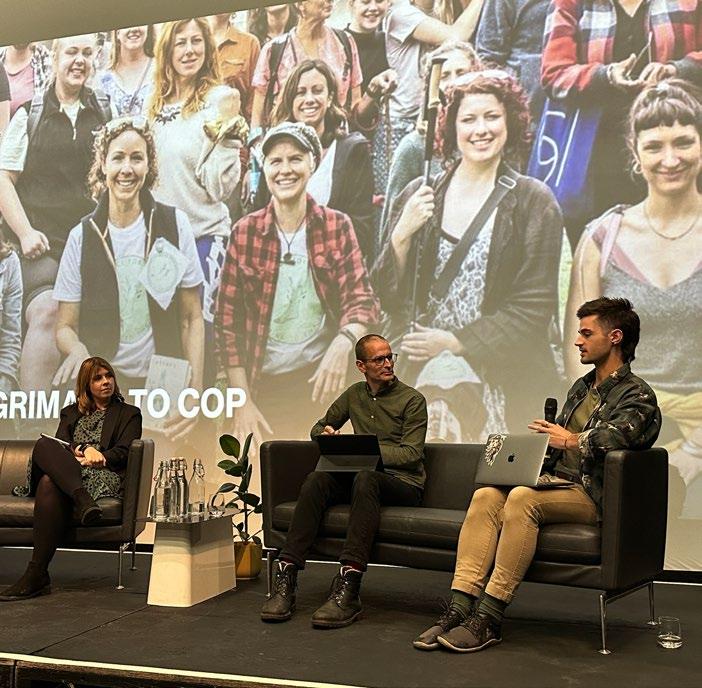
16 The One Dance UK Magazine | Spring 2024 Special Focus on Sustainability
Photo: Courtesy Julie’s Bicycle
Greener Touring Symposium presented by Julie's Bicycle with Dance Consortium
Becky Hazlewood Sheena Balkwill
“Dance has an important role to play in communicating the complex and pressing issues presented by climate change, using an imaginative, engaging and universal language.”

of 111 shows, and Edinburgh Festival Theatre, Sadler’s Wells, and Northern Stage have seen huge reductions in energy use (in some cases over 80%) by taking a rigorous approach to energy management and using technologies such as LEDs.
Julie’s Bicycle is running a new programme, Transforming Energy, which gives buildings-based organisations access to free resources on reducing energy emissions. Venues such as Farnham Maltings and Watershed Theatre are taking part and moving towards electrification of their buildings.
Dance Consortium is another organisation committed to exploring ways to reduce the impact of its activities. They have shared a variety of steps taken by their members, from reusable Velcro cable ties, living walls, waste reduction and recycling schemes, and elimination of single use plastic, to starting green teams, environmental champions on their governance Boards, and taking steps to reduce the impacts of touring. In November 2023 Julie’s Bicycle helped Dance Consortium to curate their first Greener Touring Symposium, exploring how touring can become more sustainable.
Touring is essential to artists, and sharing work internationally comes with countless benefits, but there is no escaping that traditional models of touring often rely on travelling by air, which means hefty carbon footprints, especially when transporting a whole orchestra or dance ensemble, for example.
Julie’s Bicycle is currently running the third edition of the International Touring and Environmental Responsibility programme, funded by Arts Council England, Danish Arts Foundation and Arts Council Norway. It explores the impact of touring and new possibilities for working internationally, with an opportunity to partner up and apply for seed funding for a creative project. Eliot Smith Dance took part in the second iteration of the programme, and partnered with Danish artist, musician and composer Liv Vester Larsen for MERGE, featuring an interdisciplinary contemporary dance work titled COALFIELD TO LANDSCAPE.
The project highlighted the sustainable transformation of south-east Northumberland - an area of outstanding natural beauty. It incorporated content created during workshops with the local
communities capturing artistic representations of people’s connection to the area, which were used in the performance of the work. Every element of the production was produced with sustainability in mind, using recycled costumes and found objects on set. Larsen even travelled from Denmark without flying.
Organisations are experimenting with new models for touring, for example: slow and overland travel; deep touring which allows artists to engage more meaningfully with the areas that they travel to; and the concept of moving artwork rather than the artists themselves.
We are heartened to see the action being taken but there is always more that we can do. We must collaborate, be supportive, share knowledge and learn from each other. Together we must strengthen our creative climate action to imagine and realise a brighter and more sustainable future.
Further information juliesbicycle.com
Sign up for Transforming Energy: bit.ly/JBTransformingEnergy Resources: juliesbicycle.com/resources/ Creative Climate Tools: bit.ly/JBClimateTools
The One Dance UK Magazine | Spring 2024 17 Special Focus on Sustainability
Photo: Gavin
Joynt
Balbir Singh Dance Company

Cycles of Reinvention
The award-winning hip hop theatre company Boy Blue has been making movement for 23 years, with extensive performance and education work reaching global audiences to extensive acclaim.
One Editor Cameron Ball talks with Boy Blue Co-founder and Co-Artistic Director Kenrick ‘H20’ Sandy MBE about sustaining motivation, building audiences, and maintaining a sense of purpose.
Special Focus on Sustainability 18 The One Dance UK Magazine | Spring 2024
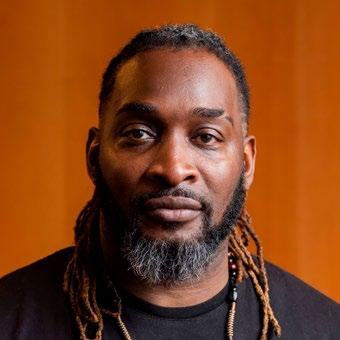
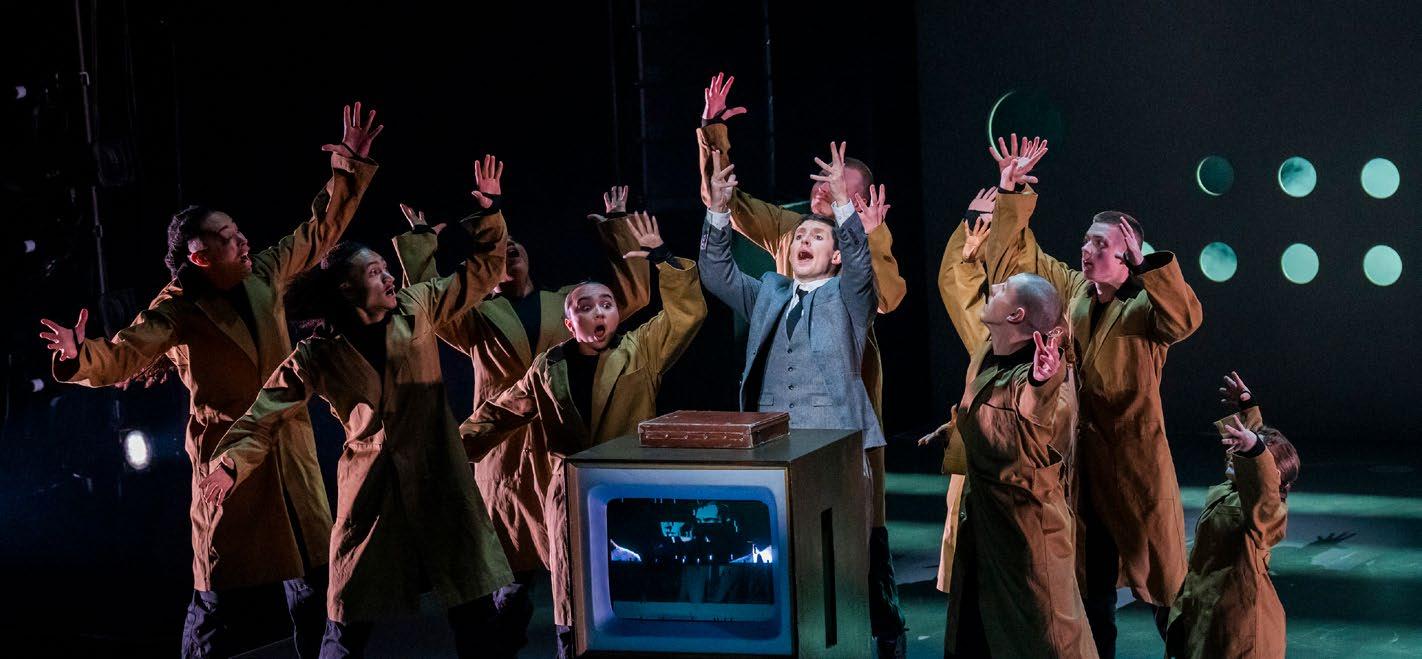
At the time of going to print, Boy Blue is preparing for the keenly awaited new production, Cycles, for the Barbican this spring. Recently the company presented Free Your Mind, a critically acclaimed, hugely ambitious immersive dance and technology experience at Manchester’s Factory International with Director Danny Boyle, featuring 50 dancers. Boy Blue’s Sunday training programmes are as busy as ever and their youth groups continue to attract hundreds of young people each week. Generating the levels of leadership and creative output expected of Kenrick ‘H20’ Sandy certainly requires a sustainable approach, and so I was interested to find out from this icon of British dance quite how he manages it all. When I sit down with him, Boy Blue was yet to go into rehearsals for Cycles and so I ask if it’s the “calm before the storm”. The immediate response? “It’s always storming” with a wry chuckle. It made me think how diverse the workload has been for this leader in the UK hip hop scene for the past two decades, keeping multiple projects afloat and planning for new ones.
Form, formula, frequency
It’s clear from the outset just how passionate Kenrick is about education. It is a thread that connects his entire career, from leading workshops in schools in Forest Gate, East London, through to thousands of young dancers coming through their education programmes and thousands more working on their celebrated work Emancipation of Expressionism (known as ‘EOE’) as part of the GCSE spec.
“No matter where we are, it's always been about education, in the sense of it’s the foundation of what we do. We go by the three Fs, which are form, formula, and frequency. Form is the fundamentals, the groundedness; the formula is the sequences, the creativity; and the frequency is the intention, the mindset, the narrative, the concept. EOE itself has all of those.”
“I'm still a student and I'm still forever learning, working on my craft. I learn from my students. I learn from my peers. The best
me will then be able to be the best future
for me and
need
to do.”
for what I
Kenrick ‘H20’ Sandy MBE
Audience development and retention
Growing a company’s organic following in dance is not always straightforward. Kenrick observes that the reach of Boy Blue’s education work helped develop an audience of loyal followers who feel personally connected to the company. “Your fanbase starts with the people who know you” he notes.
I observe that audiences might not first look to the Barbican, Boy Blue’s current home, for their fix of hip hop dance. Kenrick agrees, noting that when they premiered there in 2009, some of their audiences who followed the company from Stratford to this new home had never stepped foot
inside the building. He sees part of his role as that of breaking down barriers, increasing diversity of audiences and “cultivating the energy” of the space. He looks beyond the main stage, filling alternative spaces such as the foyers with dance jams, DJs, and general social events so audiences can connect in an informal way.
Leadership
There are lots of brilliant creative minds out there, but not all can translate their skills into being a leader and an educator for such a sustained period. How does he balance this? “I think first and foremost, you have to have a level of humility. You've got to always have a humble space where you can learn from your students. I learn a lot more about being a leader when I'm actually talking to my students, seeing how they work through certain challenges, not just dance, but in life in general. In order for you to stay in tune as a leader, you've got to understand the world constantly changes and people change with it.”
It’s clear being embedded in hip hop culture, which is known for fostering a sense of community, constantly evolving and challenging norms, is part of the fabric of his leadership style. “Boy Blue stands for going against the grain. It stands for building communities and building, like, social impact, community engagement, artistic development. That to me is, you know, some of the core things that we live by, that we want to push and want to make sure that it's not just us that develops, it's also our community, our arts community, our audience community.”
The One Dance UK Magazine | Spring 2024 19 Special Focus on Sustainability
Kenrick 'H20' Sandy MBE
Photos: Tristram Kenton & Rebbeca Lupton Free Your Mind
“I think that sometimes we fall into a space of being comfortable. We have to get to a space where we're OK with being uncomfortable, because then that's going to push us.”
Kenrick 'H20' Sandy MBE

A new production
Anyone who has experienced Boy Blue’s dynamic work will know Kenrick and co-founder Michael ‘Mikey J’ Asante dive deeply into the music, crafting new directions for hip hop theatre with a respect and passion for the techniques, history and traditions of the forms.
Known for their ferocious energy and collaborative approach with designers and other creatives, what Boy Blue are up to next will be closely watched. So what can audiences expect? Cycles promises to explore hip hop’s evolution and constant change: as Kenrick puts it, “going back to the core, back to the bounce”.
Cycles has been in the planning for over a year. Kenrick reflects on the wider programming decisions of busy multi-arts spaces such as the Barbican and the need to produce new work around a finite set of dates. “Sometimes your creativity or your outcome is led by when the commission is put out.” He is clear that building strong relationships with partner venues is crucial.
Maintaining a healthy company Dancers specialising in street styles are getting more support to maintain health and wellbeing in what can be a physically demanding and unstable profession. Those who work with Boy Blue have clear guidelines around sustaining their fitness and energy levels, with expectations that even small injuries are not just glossed over and worked through, but communicated about and treated.
Kenrick expects his dancers to be ready to work and have a mature approach to their instrument. “Make sure you're maintaining your mental and physical fitness, manage your own maintenance, take care of yourself, stretch.”
The Boy Blue company take a long warm up each day and schedule time for complete cooldown as well. Interestingly, given the physical nature of the work, they are also careful to manage break times, allowing dancers longer lunch breaks to digest their food with extra time to warm up again before rehearsals continue.
Kenrick is excited about creating new work for his appreciative audiences once more. Close to his heart, though, is the more informal showcases like the biennial, sold-out (and raucous) Night with Boy Blue, bringing up to 150 dancers from the age of six onto the stage in an evening of variety-style entertainment. “It's not about being intellectual every day. It's not about causality or the final thought every day. Sometimes it can just be just pure joy.” Connecting with people who have followed his journey for two decades, alongside newer audiences, clearly inspires him.
“I stay creative as much as possible. I'm always evaluating, I'm always reflecting, which then helps me to push my trajectory. So the more and more that I condition my mentality and condition myself, the more I can give.”
Further information boyblue.co.uk Tickets for Cycles are on sale now. barbican.org.uk/whats-on/2024/event/ boy-blue-cycles
20 The One Dance UK Magazine | Spring 2024 Special Focus on Sustainability
Boy Blue Education
Photo: Courtesy Boy Blue
Reviving a Classic
Bringing English National Ballet’s acclaimed Swan Lake in-the-round to the grand stage of the Royal Albert Hall.
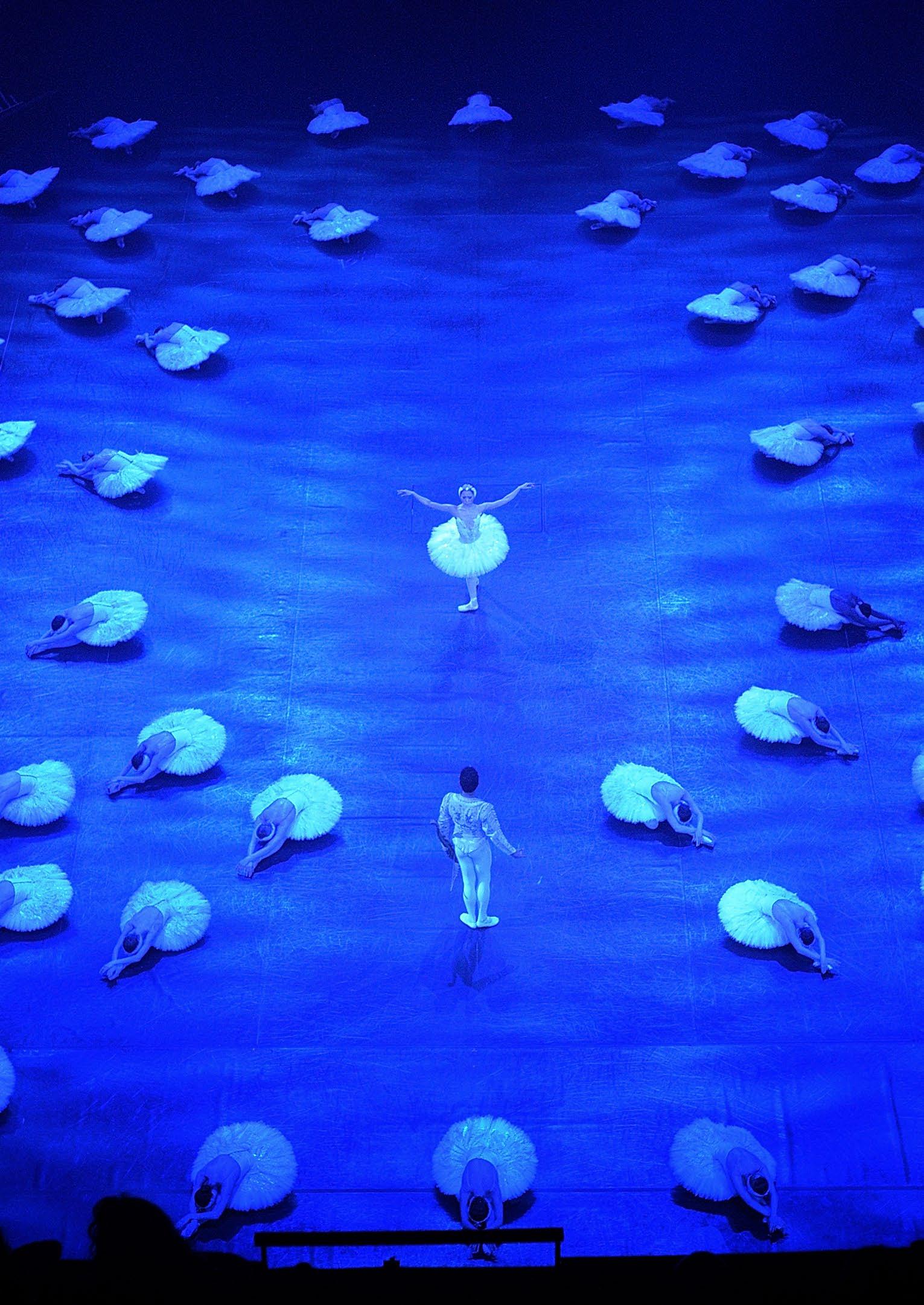
How can companies revive large-scale productions in a way that remains both exciting for audiences and work in a sustainable way for the artists and teams working behind the scenes? We investigated how department leaders at English National Ballet collaborate to bring to bring Swan Lake in-theround back to the stage this summer.
The One Dance UK Magazine | Spring 2024 21 Special Focus on Sustainability
“No dancer is the same – it stays the same choreographically, but everyone responds to it differently, emotionally.”
Derek Deane
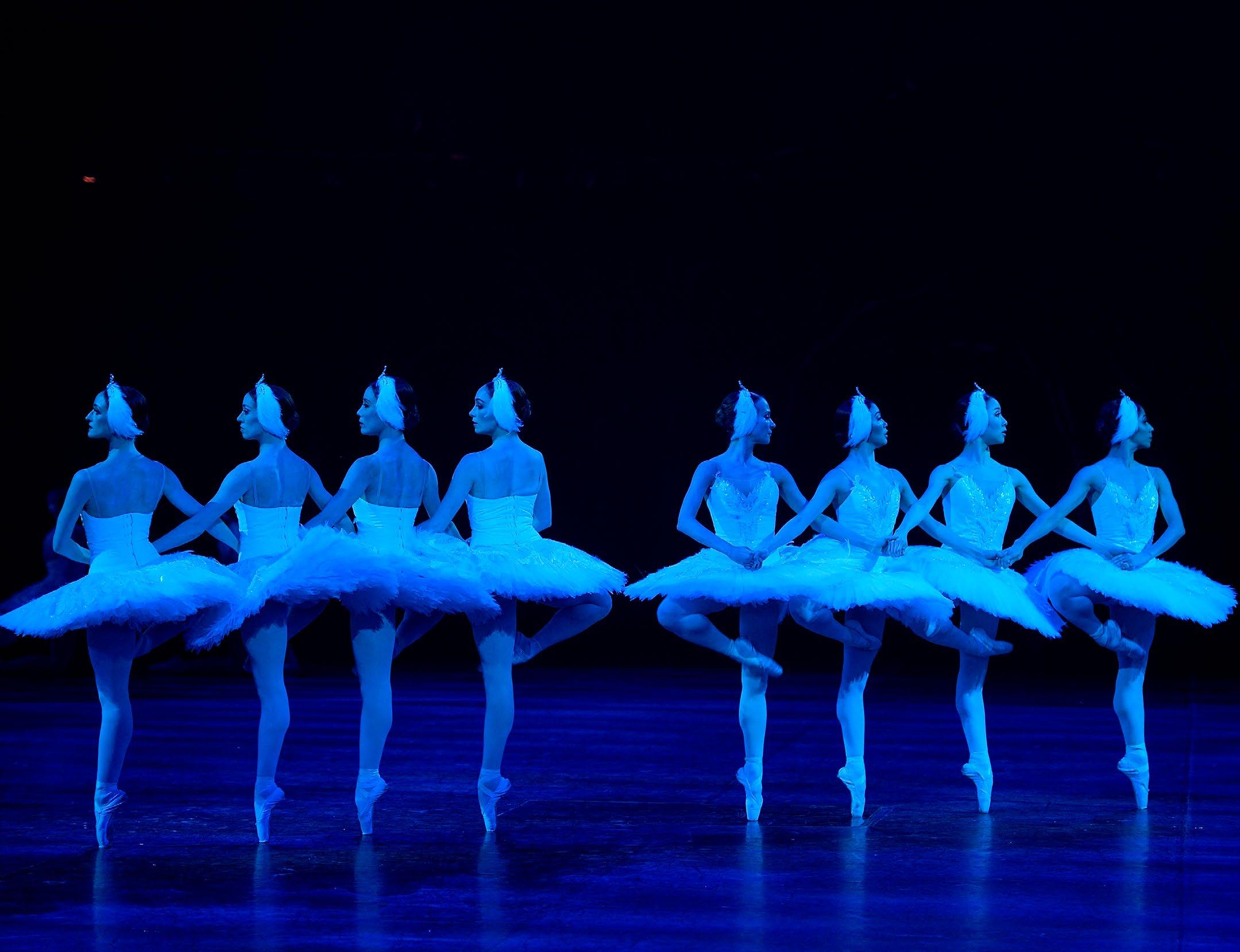
Swan Lake in-the-round captures the splendour of ballet on a grand scale. With over 100 performers, including 60 swans, stunning costumes and atmospheric lighting, this in-the-round production brings the classic love story to life on one of the world’s most famous stages: the Royal Albert Hall.
First performed by the Company in Verona, in 1964, Swan Lake is a treasured production in English National Ballet's repertoire. This version, choreographed by Derek Deane in 1997, has been enjoyed by over half a million people worldwide, both dedicated fans and first-time balletgoers. Over two decades later, this ballet still mesmerises audiences.
To make the magic happen, there is a vast team working collaboratively towards the success of this production, ensuring it is sustainable in terms of resource but also ensuring the dancers are equipped to perform at their best across a demanding 11day run.
Three leaders from English National Ballet involved with the production share their thoughts.
Derek Deane
Choreographer, Swan Lake in-theround (after Petipa and Ivanov)
“On the approach to each revival: I always try to come back fresh, with an open mind. We are always learning. You never stop learning. What I really enjoy are the different dancers that I am working with.
On favourite elements of staging the production: I enjoy the studio work and I really enjoy getting out on stage and seeing the set, the lights, and all of that process. Swan Lake is not necessarily about the individual steps – it is also about how convincing you can be in the character you are playing. For me, there has to be a reason for every gesture and every look. It is about storytelling through the music.
Swan Lake is not just about the white acts! You have so many different
character dances which balance the production, like the Mazurka, the Czardas, the Neapolitan, the Spanish, the Peasant Dance in Act One. These are all heavy and ground-based choreographically, and they really support and balance the production against all the softness and beauty of the white acts.”
Adrian van Winkelhof Head of Performance
Coaching
and Development
“Swan Lake is the cornerstone of the classical repertoire for a ballet company. It requires a depth of highly trained and disciplined dancers in all the ranks. Yet, it is the female members of the corps de ballet that are considered the backbone of Swan Lake as they often have to perform in all four acts in every performance.
English National Ballet has a multidisciplinary team of physiotherapists, nutritionists, psychologists, strength trainers, and performance & mindset coaching that support the dancers’
22 The One Dance UK Magazine | Spring 2024 Special Focus on Sustainability
Photo: Laurent Liotardo
Dancers of English National Ballet in Swan Lake in-the-round
Swan Lake in-theround: in numbers
• 60 swans
• 100+ performers
• 32 fouetté turns in the Black Swan pas de deux
• 4,000+ pairs of pointe shoes wore through the Season
• 8,000 bars of music in the score, performed live by the English National Ballet Philharmonic
• 500,000+ audience members have experienced the production around the world
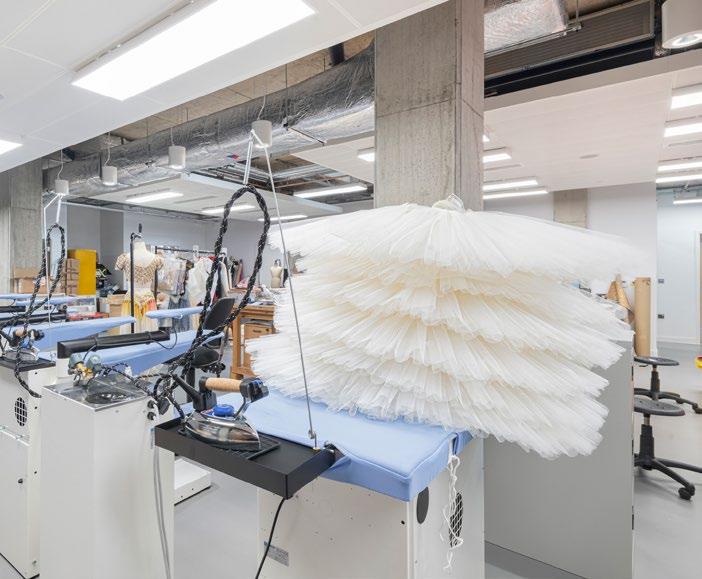
physical and mental health wellbeing. This holistic approach to dancer well-being hopefully empowers the dancers to meet the challenging demands of Swan Lake and sustainably excel in their dancing.”
Lola Stott
Wardrobe Manager
“Derek Deane’s Swan Lake in-theround was originally designed by Peter Farmer and first performed in 1997. Incredibly, we still have the majority of those costumes in circulation, and they have been used in every production since. That’s 27 years!
“When the brief is to recreate 60 identical Swan tutus to appear on stage at the same time, every scrap of material is precious.”
Lola Stott
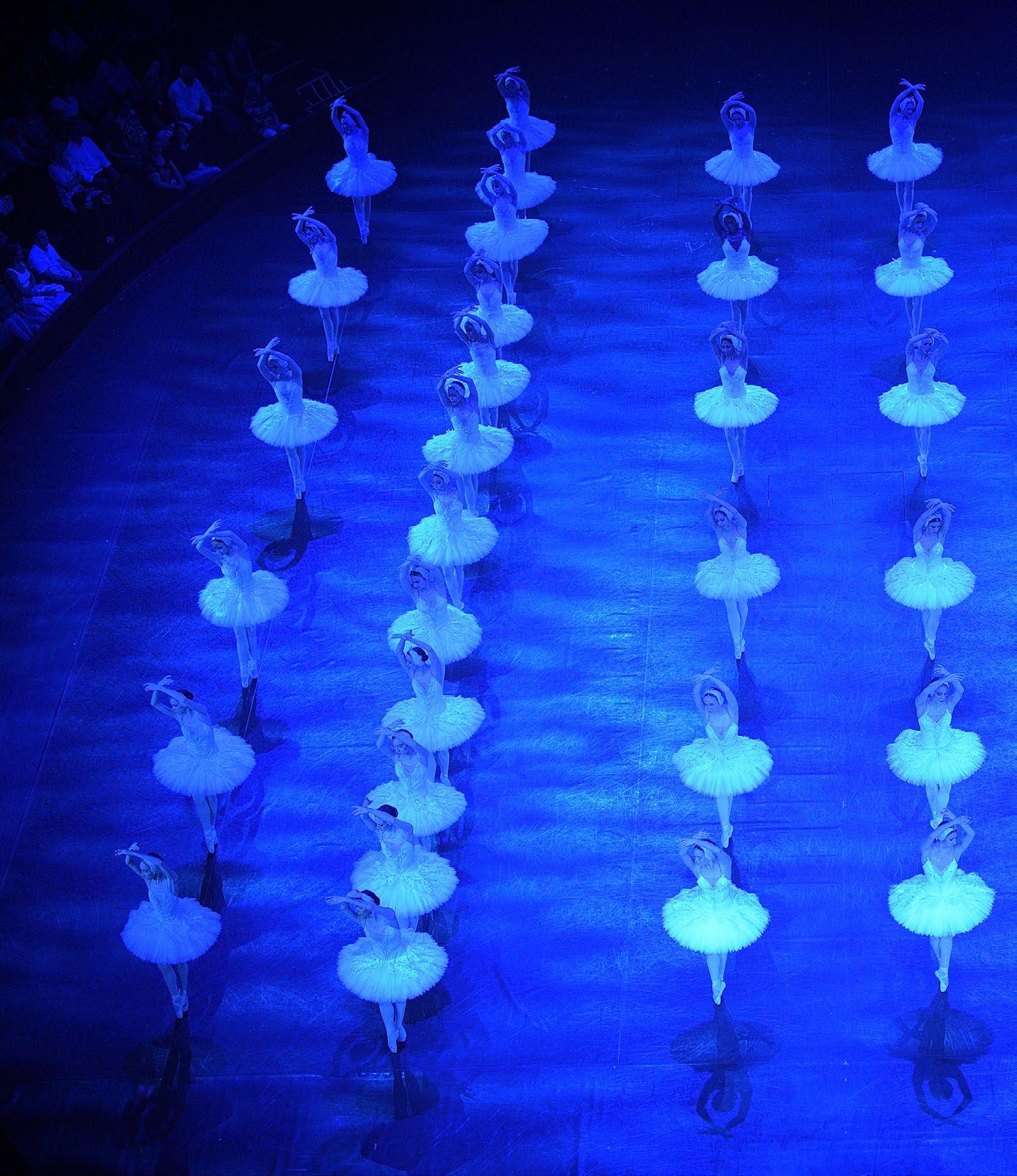
“The scale of this production and the size of the stage at the Royal Albert Hall further compound the level of stamina, endurance and focus required by our dancers.”
Adrian van Winkelhof
This has been achieved by hours of refurbishment and maintenance that is meticulously carried out by our extraordinarily skilled and experienced Touring wardrobe department, comprising of a tailor and two ladies' makers. The work at times can be more of an exercise in conservation with the removal of rusty fastenings, and delicate darning on a wealth of fabrics ranging from silk to heavy brocadesmost of which are now discontinued. When we approach a revival, we begin by fitting all the existing costumes as per the casting, this may involve alterations of side seams, sleeves, or hem length adjustments to achieve the perfect fit. We need our dancers to feel comfortable and confident in the costumes they wear. We can reuse our costumes due to the quality and durability of the fabrics used when they were originally made. We also ask our makers to leave generous seam allowances to future-proof to a degree as body shapes evolve over the years.
The Swan tutus are a set of
costumes that have had numerous remakes over the years, due to droopy tutu bases or discoloured bodices. Even though we detach, scrub and even machine wash the bodices, there is a point when they too have to retire - although nothing is ever thrown away as we can unpick the lace detail or braid and reuse.”
English National Ballet’s Swan Lake in-the-round returns to the Royal Albert Hall from 1223 June, combining gorgeous spectacle, compelling drama and touching intimacy, with Tchaikovsky’s memorable score played live by the English National Ballet Philharmonic.
Further information ballet.org.uk/production/swan-lake-inthe-round
The One Dance UK Magazine | Spring 2024 23 Special Focus on Sustainability
Photos: Michael Molloy & Laurent Liotardo
Dancers of English National Ballet in Swan Lake in-the-round
English National Ballets new home on London City Island costume department
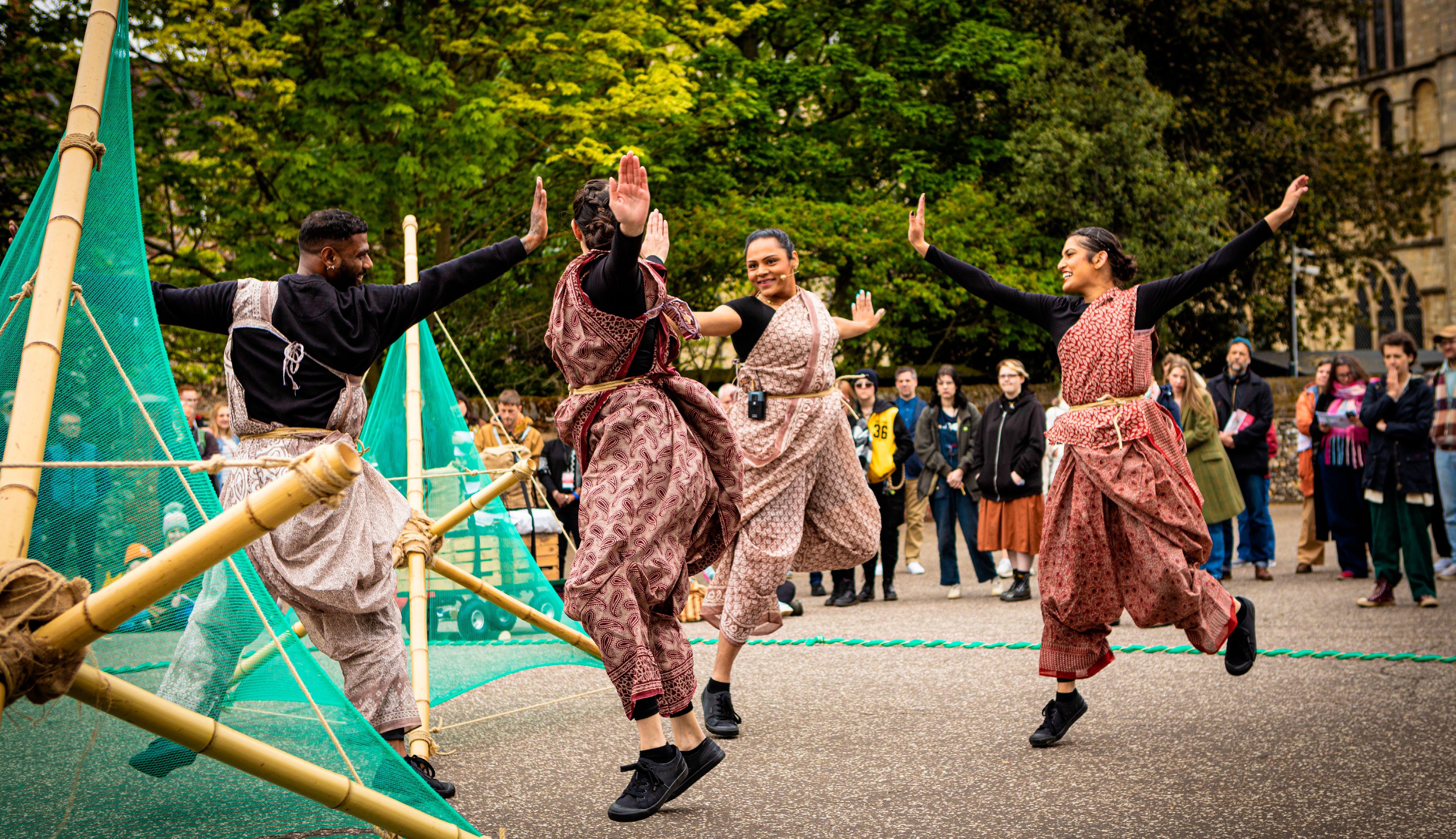
“I wanted to express and share stories of the people whose lives and livelihoods are affected by climate change across South Asia and also the world. My research in Sagar, an island close to the Sundarbans in West Bengal, reiterated the notion of hope. Choreographed by Vidya Patel, Pravaas is a hopeful piece with emotions,
resonances and stories woven together through South Asian dance and music. I believe that dance has the power to move people and embody emotions. We worked closely with Without Walls to ensure that sustainability is considered in every aspect of Pravaas - from its creation to its touring.”
24 The One Dance UK Magazine | Spring 2024
“The link of the movement of people and movement in dance is one of many reasons I wanted this to be the subject of this work.”
 SUBA SUBRAMANIAM
SUBA SUBRAMANIAM
Artistic Director, Pravaas and Akademi Pravaas was awarded the Green Dance Award at the One Dance UK Awards this spring.

Scan the QR code to watch a Moment of Movement:

Moment of Movement
The One Dance UK Magazine | Spring 2024 25
Photo by Justin Jones
Creative Exports
Forging international links by Cate Canniffe, Arts Council England’s Director, Dance and London.
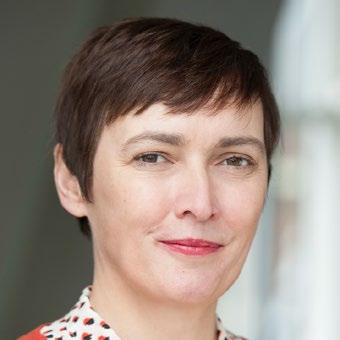

The UK is a global centre of creativity. That is because of the talented people who live and work here, but it is also because of the outward-looking approach our artists and cultural organisations take to collaborating with their peers around the world. This helps to bring more world-class talent to our country, and gives artists based here the chance to share their work with international audiences.
Arts Council England supports international work through our core programmes including our Investment Programme, National Lottery Project Grants and Developing Your Creative Practice. But we also invest in specific programmes to help sustain and strengthen the relationships England’s dance sector has with its counterparts in other countries.
One project that supports this kind of work is Open Dialogo. A UK-Italy programme jointly funded by the Arts Council, British Council, the Italian Ministry of Culture, and the Italian Cultural Institute of London, Open Dialogo supports collaboration between dancers and cultural organisations in both
countries, who are interested in exploring the relationship between dance and disability. Through the programme, two artists in England undertake a residency with Italian cultural organisations, and vice versa, to help build relationships between the respective dance sectors by sharing knowledge and exploring new approaches to disability and inclusivity in dance.
We also invest to help develop networks between artists across the UK, and to help these networks collaborate with international partners. The Four Nations International Fund is one programme that takes this approach, investing in partnerships between two artists based in England, Wales, Scotland and Northern Ireland who want to work with another partner based overseas.
Another approach to international working is our support for programmes that help England-based artists to showcase their work for global audiences.
One such project, run by FABRIC, is the Horizon showcase, which supports artists and organisations to perform at the Edinburgh Festival Fringe, showcasing their work for an audience
of international cultural professionals. By putting the work of England’s artists on these kinds of platforms, we open up opportunities for them to secure tours and other work in international markets and enhance the reputation of England’s dance (and theatre) sector around the world.
“Art, culture and creativity thrives on collaboration.”
We all benefit when that takes place across borders – creatives can collaborate with the most talented of their peers, audiences get to experience the most ambitious and innovative work from around the world, and the dance sector benefits from the building of new markets and audiences for UK dance.
The Arts Council is proud to support these initiatives, and we look forward to working with partners in the UK and beyond to create even more opportunities for the UK’s dance artists to work across the world in the future.
Further Information
26 The One Dance UK Magazine | Spring 2024 Special Focus on Sustainability
Make the case for publicly funded arts and culture: artscouncil.co.uk/make-case-creativity-and-culture
Cate Canniffe
Photos: Philippa Gedge Photography & Johan Pijpops
Sung Im Her-Nutcrusher, presented by FABRIC at Horizon Showcase, Edinburgh Festival Fringe 2022
Shechter II:
Developing Dancers for Sustainable Careers
Lucy Moelwyn-Hughes on the innovative development programme offering early career artists high quality performance and support opportunities.
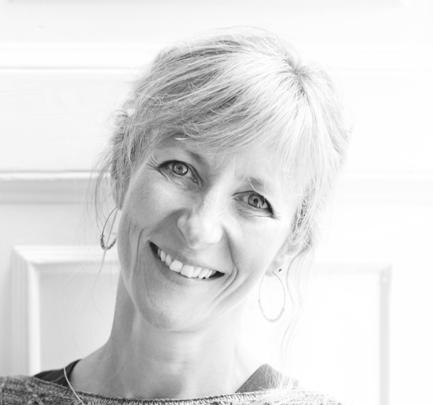

In 2017, with a history of almost 10 years of successful large scale production and touring at Hofesh Shechter Company, we began to think about how we could create work with a wider reach, particularly in the UK, that would regularly connect with new audiences and bring in a new generation of dancers who young people looking for new live experiences might identify with. Add to this Hofesh’s personal commitment to giving young dancers lifechanging opportunities, which mirrored his own journey into dance, and so Shechter II was born.
We ran a pilot in 2018, offering a paid professional development programme for emerging artists aged 18-25. After open international auditions, we found 8 amazing dancers. It was our 10th anniversary, and a landmark year, and these extraordinary young artists were bringing their production SHOW to stages across the UK and Europe, winning the Best Newcomers award in Paris and performing in the memorable East Wall largescale participatory project at the Tower of London. It was incredible. And since then, we haven’t looked back.
We now run the programme every two years, attracting over 1,200 dancers from 34 countries to our open auditions. Our dancers spend a year with us, creating a new work with Hofesh, (often a reimagining of a largescale work, recreated for them at the midscale) during which they are in real proximity to the workings and practices of a major international touring dance company.
As well as the creation and 9-10 months of UK and European touring and showcasing, we also offer Continued Professional Development throughout the year. This includes orientation, a week of creation with another choreographer, workshop leadership training, dance science, health and wellbeing and self-directed research and development, all supported by an experienced team at Hofesh Shechter Company. Alongside their performances, they are also delivering outreach projects, making connections to local communities and aspiring dancers who we hope see these exciting, diverse artists as role models and examples of dancers on a pathway into the profession.
Ultimately, we aim to nurture and grow proactive professionals able to enter the sector as rounded industry-
conscious young artists, with the skills and knowledge to enjoy sustainable and outstanding careers, long into their futures.
“What a total blessing this year has been and wow… how MUCH have I learnt.”
Chanel Vyent, Shechter II dancer 2022
From April 2024, the eight dancers of our Shechter II 2024 cohort will embark on a UK and international tour of From England with Love, a compelling new work in which the multi-layered complexity of England takes centre stage.
Further information
From England with Love tours from April 2024, with its UK premiere at Southbank Centre, Queen Elizabeth Hall, London. For tour dates visit hofesh.co.uk
Read about Southbank Centre’s approach to programming dance on page 39.
Hofesh Shechter Company gratefully receives support towards the delivery of Shechter II 2024. This includes core funding from John Ellerman Foundation and The Harold Hyam Wingate Foundation and project funding from Jerwood Foundation towards Jerwood �� SII – a new Continued Professional Development offer to the dancers.
The One Dance UK Magazine | Spring 2024 27 Special Focus on Sustainability
Photos: Amanda Taylor & Tom Visser
Shechter II in Hofesh Shechter's From England with Love
Creative Honesty
Dance artist Stuart Waters has not been afraid to explore hard-hitting topics such as addiction and disability in his work. Head of Workforce Development Chinyere Ogbue talks with him on how he sustains his creativity and how he has grown the courage to put the full, sometimes uncomfortable, human experience in front of audiences in dance form.
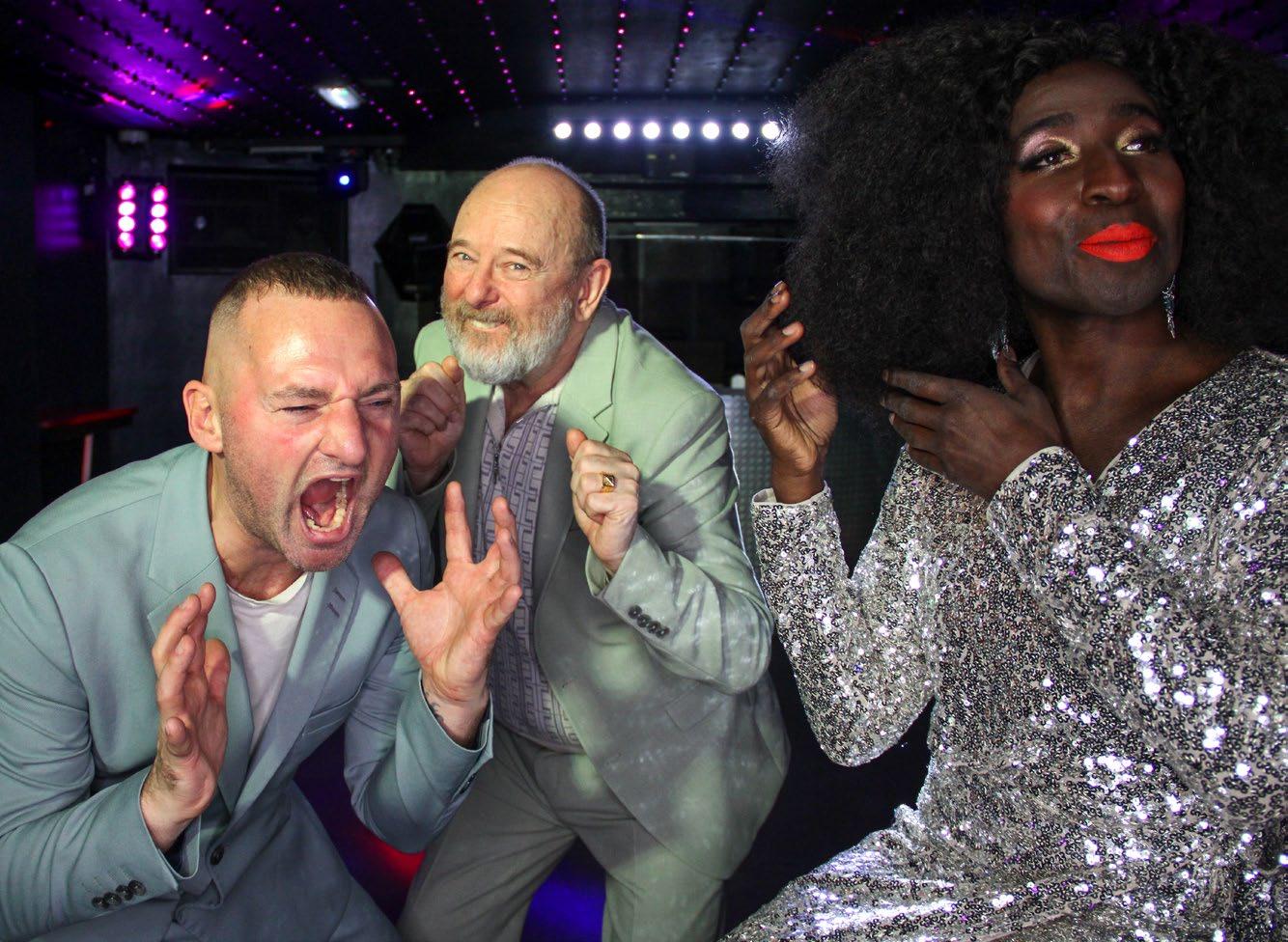
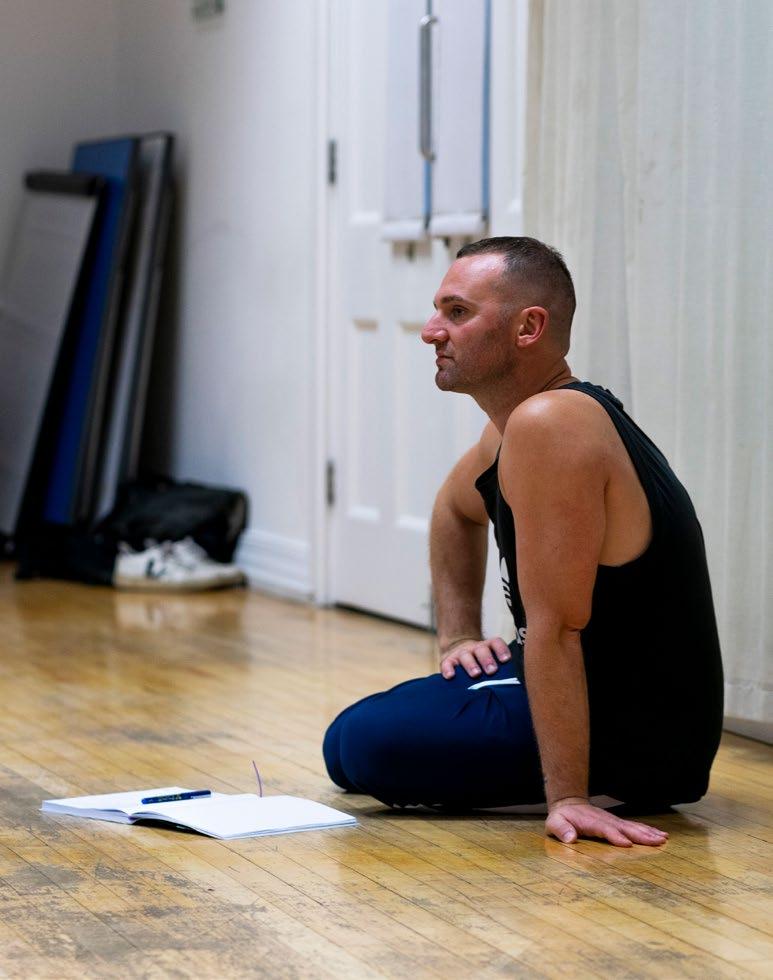

“Marginalised communities and stories are ones I would love to see more of in venues: people in sobriety, recovery, mental health, neurodiversity, queer communities, and disability. And of course, a lot of that is intersectional.”
28 The One Dance UK Magazine | Spring 2024 Special Focus on Sustainability
Stuart Waters
Photos:
Antony Edwards & James Curtis
Stuart Waters, Willie Elliot, Ebony Rose Dark, A Queer Collision
Stuart Waters at The Place - Choreodrome 19
Rajan Das, A Queer Collision
It’s noted how your body of work explores interesting areas around the human condition. Why do you choose to focus your work on topics like health and wellbeing and identity?
I would say my whole life, both privately and in the context of dance, has been made up of uncomfortable experiences. I would like to contribute to a step change in the amplification of stories and voices around all those things.
In a way, it's a reframing of some of my own experiences and realising that some of my discomfort can be useful for others.
The titles of your recent works, ‘A Queer Collision’ and ‘Rockbottom’, could be seen as provocative. What was the intention when choosing these titles?
I guess they could be perceived as provocative because of the themes, but there's nothing provocative about that. They are based on my lived experiences. My practice is live; therefore I explore different ways of telling stories, using different genres.
With A Queer Collision and Rockbottom specifically, I chose consciously for them to be accessible pieces of dance theatre. This is what felt right for those two works. I wanted the titles to give a clear signal and I wanted to centralise autobiographies and storytelling.
Rockbottom was created under the umbrella of mental health and through that three-year process, I grew the courage to talk more about what that really meant. At the beginning, I was talking about mental health generically, and then I realised I'm not hiding from it. I'm talking about my journey. With a title like Rockbottom, it's quite clear what that is.
With A Queer Collision, I wanted to go wider and bring in other autobiographies that align with mine. Willie Elliott was an audio describer for me on tour with Rockbottom. And my producer at the time, Vicky Balaam, planted the seed about embedded access. Coming out of Rockbottom and into A Queer Collision,
I was going through a phase of realising and changing my language around my hidden disabilities.
A Queer Collision’s centralising of disability and access meant that it created an interesting layer - that's where the word ‘collision’ comes from because it felt like a collision. I think Willie would agree that we did a good job of developing and finding new techniques of using audio description in dance performance.
In the four years it took to make A Queer Collision, how were you able to sustain your creativity? How did you centralise bringing communities together for the work?
I think A Queer Collision is a great example of how quite complex intersectionally-led practice for communities and audiences can be achieved. Creatively, once my imagination kicks in, and I visualise something, I feel like it's locked in. As exhausting and challenging as fundraising can be, in some strange way it supports the drive because it makes me more determined. Also, having an enforced break from a project, and having time to process and evaluate, other things start to drop and change in my mind. And with a piece of work like this, it needed it.
The first part of the process was researching whether embedded audio description of a script would work. Then I brought in other queer voices, and thinking about how the piece would work in various venues. Taking over venues, making them disabled and queer friendly, and connecting with queer communities around the country, learning and hearing their stories, all kept me busy.
Rockbottom is quite raw, based on your own personal journey. What did you take from that experience in creating and performing it?
That they are important stories to hear. There is a community of people that deserve to have work about their lives made, and that is why I think themes of recovery and addiction are important and relevant to have on stage.
There’s a lot of work around deshaming and fear around working with addiction, which I think is why people don't focus so much on recovery arts or find themselves in that place.
I really find it interesting how people who don't have any direct association to recovery, addiction or mental health conditions will see a different experience of their own within that. Then people start to normalise what feels like quite an extreme behaviour a little bit, because they've seen parts of themselves in a response or a human behaviour. I like that crossover.
“Being creative is never a problem for me – that is the gift and the curse of neurodiversity.”
Thinking about younger queer artists trying to embark on their own artistic journey, what advice would you give?
I've always been open and curious. I collected different performance experiences and different settings with different companies and styles. Sometimes I've gone through bigger periods of teaching and not performing. And then the performing arrived again, and it stayed. I think it’s important to learn to listen to where everything is telling you to go. I'm still trying to do that. Remain open, keep developing.
I also think we should let emerging artists know that it's going to be challenging, more than they probably realise. Reframing what they think resilience might look like would be useful. And though we're encouraged to keep going, trying everything with a bit of a fighting edge, you can do that in a kinder and healthier way.
Further information www.stuartwaters.info recovery-arts.org/performing-recoverymagazine/
Listen to a longer version of Chinyere and Stuart’s conversation by scanning the
QR code.
The One Dance UK Magazine | Spring 2024 29 Special Focus on Sustainability
Neurodiversity in the Studio
Exploring inclusive practices in dance spaces
Phaedra Petsilas, Head of Studies at Rambert School, reflects on a collaborative research project with Rambert School and Move Beyond Words, supported by One Dance UK.

“…in diversity there is beauty and there is strength.”(Maya Angelou) As I begin to write this article, I am reflecting on the plethora of voices that have called for more diverse, equitable and inclusive environments in dance education. On how our pedagogic systems within Western dance training contexts have evolved to embrace a multiplicity of approaches, both in terms of what we teach but also how we teach it.
Practitioner-scholar and somatic educator Simone Fortin contends that ‘to move forward as an art form, there is a need to transform … our pedagogical outlooks’ (Fortin, 1998). Within the dance training context, ‘pedagogical outlooks’ are influenced by and interact with dominant ideologies, institutional priorities and wider societal concerns. We are also in constant dialogue with the professional dance sector and the ever-shifting expectations placed on dancers as they embark on a career. Within a conservatoire dance setting, the aim is to become physically and creatively versatile with the ultimate goal of employability, and dancers must constantly prove themselves and their abilities. Dance training is intense and intensive, and the experience of it can vary dramatically from person to person.
There are disabling structures and systems within our pedagogies, and although there are excellent examples of inclusive practice in some dance settings, research and knowledge exchange are vital in keeping the dialogue on equity and inclusion alive and current. To this end, I am delighted to be sharing the Rambert School funded research project Neurodiversity in the Studio (2023). The project was a collaboration between Rambert School and Move Beyond Words, led by Rambert School alumna and co-founder of Move Beyond Words, Charlotte Edmonds, alongside Researcher Jessica Lowe (One Dance UK). The School’s ethos is built on equity and inclusion, following Marie Rambert’s statement of (inclusive) intent that the school is not a “sausage factory”, now expressed as “excellence comes in all forms”.
This collaboration was an excellent opportunity to connect with Move Beyond Words who have been conducting research surrounding the prevalence of dyslexia amongst performers, and also celebrating neurodivergent voices within dance and the arts. Having the support of One Dance UK for both the delivery and dissemination of this project has been invaluable.
“Acknowledging the multiplicity of experiences within any given training system is a vital first step in fostering sustainably equitable and inclusive dance environments.”
Our project focused on developing support strategies for neurodivergent and neurotypical dancers within the studio and in high intensity environments and was conducted with Rambert School 2nd year degree students. It comprised four workshop interventions focusing on a range of practical skills and embedded creative and reflective tasks.
More specifically, we conducted tasks surrounding learning styles and working methods, facilitated choreography designed to explore how dancers’ access, process and retain information. We aimed to discover collaboratively how dancers operate within the studio environment, how they acknowledge their learning styles and processes and utilise them to their advantage, but also how they can support peers. High intensity environments in dance training and the professional world can be overwhelming and stress inducing. From personal
30 The One Dance UK Magazine | Spring 2024 Special Focus on Sustainability
Phaedra Petsilas
Photo: James Keates Photography
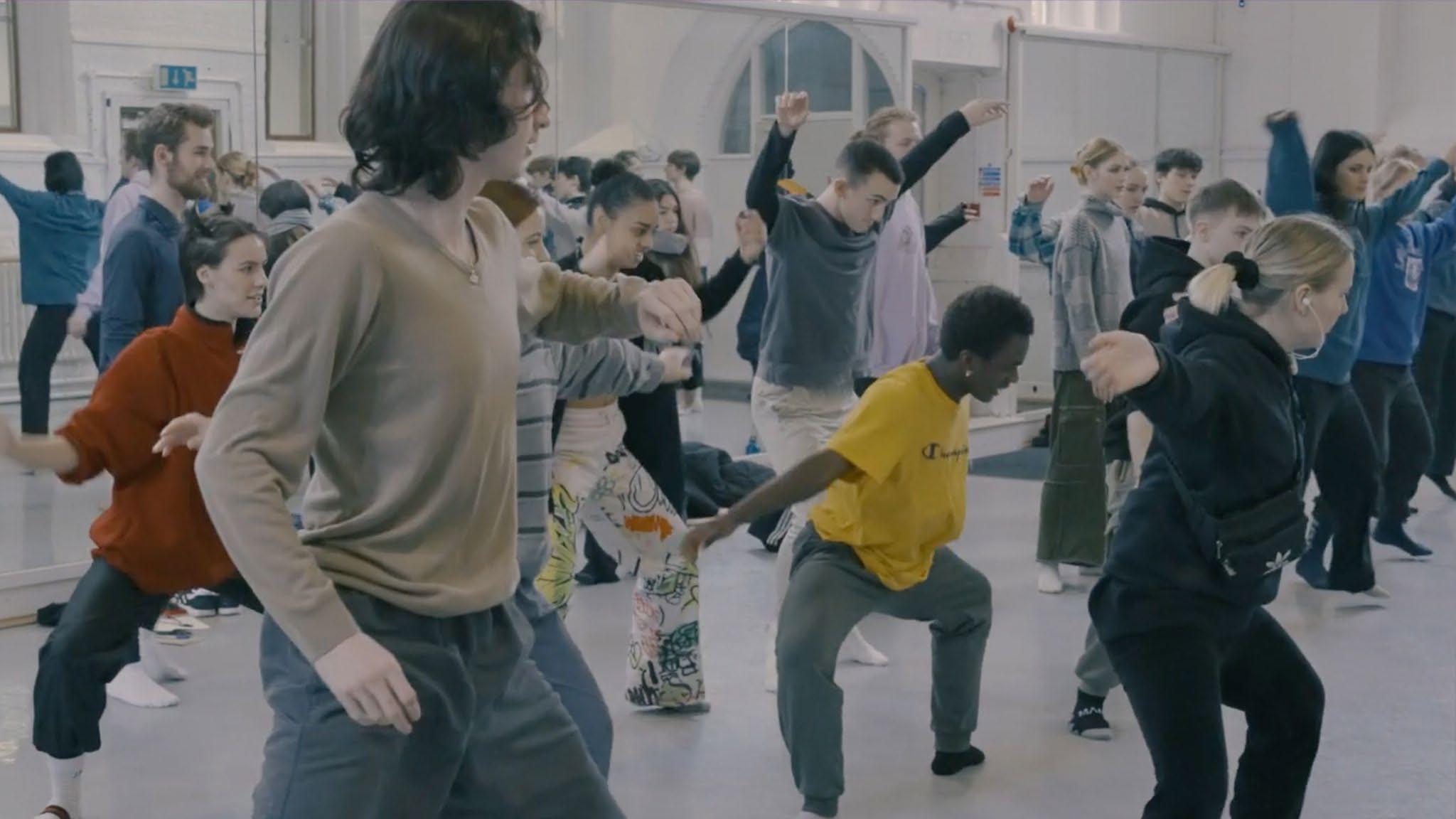
experiences within our research team, we know neurodivergent people have struggled with working in the industry as professional artists. Navigating our careers can be a frustrating obstacle course and lonely process which ultimately has an effect on our perception of ourselves and our abilities, as well as our mental health, which is vital to nurture and support us in persevering and accomplishing our professional goals. What was deemed as vital was the collaboration with the students, the embedding of their lived experiences and perspectives into the project from the outset, the recognition of their voices as central to understanding how we can arrive at a shared notion of inclusion and access in the studio. By collaboratively exploring diverse ways of being, feeling, learning, doing, dancing in the studio, we considered strategies to alleviate challenges dancers might face within stressful environments.
We focused on:
• Developing support strategies for neurodivergent and neurotypical dancers within the dance studio, such as exploring learning styles and how they pan out when learning movement under pressure.
• Developing tools to support mental wellbeing before, during and after
intensity activities, such as identifying needs and ways of sharing access requirements.
“This process was vital in promoting confidence and agency in the young dancers to not only celebrate differences, but also to have the tools to express their needs or to hold space in an inclusive way.”
Our aims were for dancers to come away with an enhanced awareness of neurodiversity, a deeper understanding of the impact of disabling structures or processes, an increased sense of empathy for fellow dancers and their potential needs, and the practical tools to support them (e.g. sharing access needs).
During the interventions, we embedded individual and group reflective tasks, as well as encouraged criticality and questioning. Neurodiversity was explored through discussions, but also in embodied ways, such as exploring definitions of neurodivergence choreographically.
Reflection and ‘thinking-through’ creatively and physically, promoted a deeper sense of empathy, and utilising art, music and movement was a vehicle to encourage communication and feel/sense before articulating in language. What came out of the reflections very strongly is the notion of unlearning the internalised notions of being ‘less-than’ as a neurodivergent person. Dismantling the perceptions of not being good enough, or not working hard enough is really important. During the project intervention, we arrived at a deeper and more nuanced understanding of each others’ experiences and needs, which highlighted a potential lack of education within our wider pedagogic systems on how neurodiversity is expressed, negotiated and supported, particularly as it relates to being in the studio.
What was crucial, and expressed clearly by the student participants as they reflected on the learning at the end of the project, is that “…we don’t need a set of new rules…” (Project Participant, 2023). Our dance spaces, educational or professional, need to be “adaptable and malleable” (ibid.). As facilitators of creative spaces, we need to be open-minded and flexible in our approach in order to respond to dancers’ needs within
The One Dance UK Magazine | Spring 2024 31 Special Focus on Sustainability
high
Move Beyond Words participants
Photo: James Cooperman and Sophia Melvin
“Choreographers, educators, and rehearsal directors collaborate with a diverse array of talented dancers.This project is designed to help navigate neurodiversity and address accessibility requirements, allowing the dancers to work in an inclusive environment to reach their full potential.”
Charlotte Edmonds
Choreographer and Co-Founder, Move Beyond Words
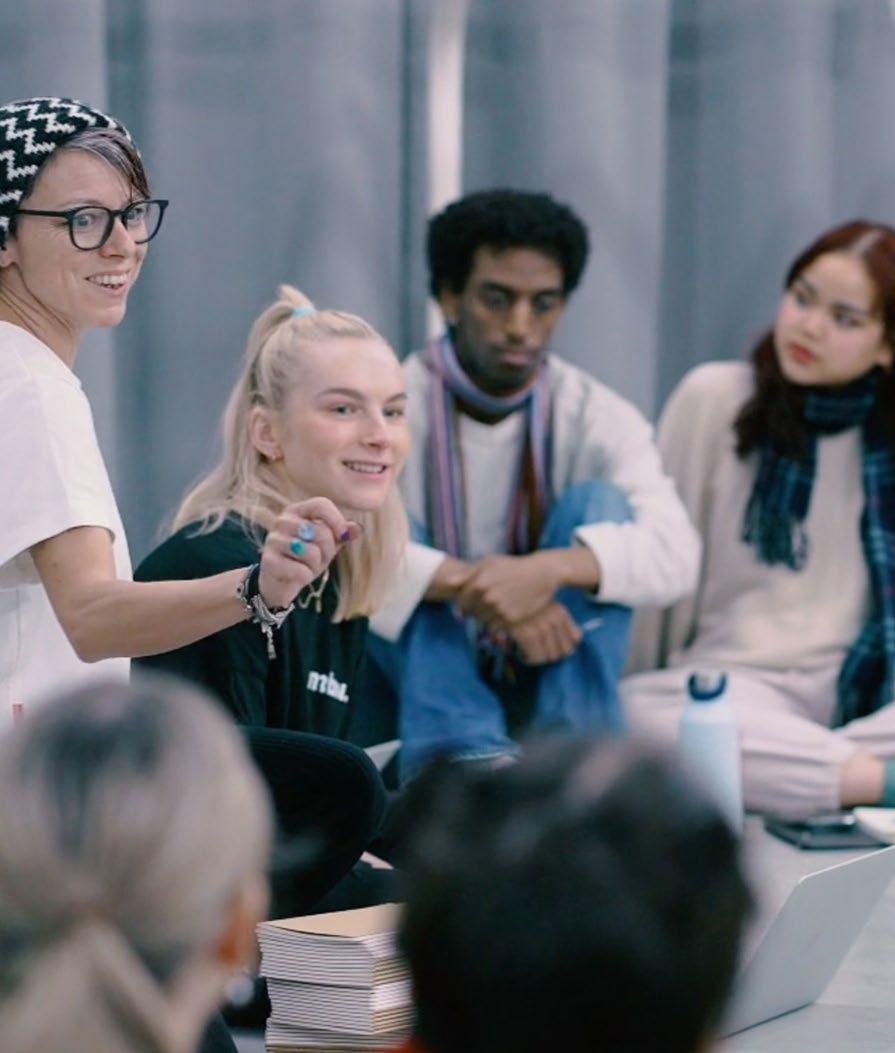
the various situations and contexts.
An overwhelmingly unanimous reflection was the need for collaboration and representation but also fostering a sense of belonging and open communication. Further reflections centred around awareness of stereotypes and how we often compartmentalise and fix access needs. What emerged was the changing nature of access dependent on context and that there is both an individual and a collective responsibility to ensure needs are met. There are so many things to contend with as a dancer, particularly in high intensity situations (e.g. an audition), and students questioned why someone who is neurodivergent should have to adapt considering the amount of “extra layers of effort that they already are having to deal with on any given day”.
(Project Participant, 2023)
The practical tools that were most impactful for the students were exploring learning styles through
movement, designing inclusive scenarios for a range of dance settings and discussing access riders, created by Alexandra Hemsley. These deepened students’ understanding of how different body-minds might work in a studio setting, how to plan for an inclusive project and how important it is to share needs in a structured way. In turn, this highlighted the value of addressing these topics during training and dismantling the notion that was shared by the students that sharing access needs may be detrimental to getting a job or progressing professionally.
We all discovered that working inclusively is an ongoing process built on open communication and acknowledgment of the diverse contexts we might be working in. We wanted to reframe the conversation around neurodiversity to include how we work together in dance spaces and beyond the academic sphere, and by exploring it creatively and within a studio setting, we hope we discovered
some useful ways in developing professional self-sufficiency. This research can have a wider impact on how dancers operate within the profession in future dancing, making, and leadership roles. Ultimately, we cannot design effective pedagogic systems that foster a sense of belonging unless we “…insist that everyone’s presence is acknowledged” (bell hooks).
Further information
Watch a short film about the project: bit.ly/BeyondWordsFilm
rambertschool.org.uk
movebeyondwords.co.uk
One Dance UK’s Considering Difference resource: bit.ly/ConsideringDifference
32 The One Dance UK Magazine | Spring 2024 Special Focus on Sustainability
Photo: James Cooperman and Sophia Melvin
Phaedra Petsilas, Charlotte Edmonds and Move Beyond Words participants
Dance and Parenthood
The impacts of pregnancy and caring responsibilities on freelance mothers in dance by

Dr Angela Pickard
There is a paucity of research on barriers and challenges dancers/ dance artists face in pregnancy, and with those with caring responsibilities, around inclusive working practices, and specifically about the physical impact of pregnancy and childbirth on dancers/dance artists’ safe return to work.
I recently undertook research commissioned by the charity Parents and Carers in Performing Arts (PiPA), funded by Dance Professionals Fund, and investigated the impact of pregnancy and caring responsibilities on the careers of freelance dancers and dance artists in the UK. The qualitative study was based on interviews and focus groups and is a snapshot of experiences of 40 freelance dancers and dance artists (n=34 mothers and n=6 fathers), from different backgrounds and styles within the contemporary dance sector, working for established as well as smaller scale dance companies.
Findings revealed that freelance dancers/dance artists, who are mothers, can be impacted physically, psychologically, socially, and financially, during pregnancy, on becoming
Dr Angela Pickard.
“This important work contributes to wider conversations around diversity, inclusion, sustainability and retention for longevity in the dance profession.”

a mother, and in balancing caring responsibilities with a career in dance. Concerning trends were identified from the research that include risk of injury and exhaustion, as new mothers feel pressures to return to work too soon after having a baby, and that mothers struggle to balance caring responsibilities with a dance career. This is jeopardising the safety and wellbeing of freelance mothers, and risks talent loss of highly experienced dancers in the sector.
Key findings include:
• Fear of Discrimination: 71% of mothers reported extensive deliberation before starting a family, fearing repercussions on their careers. The absence of visible role models perpetuates a lack of awareness and understanding of pregnancy and parenthood in dance, leading to identity crisis and talent drain.
• Returning to Work Too Soon: 75% of mothers in the study returned to work within six months after giving birth, risking physical exhaustion and injury. Financial pressures and fear of losing essential work connections drive new mothers to
return to work before they may be fully recovered.
• Work and Life Conflict: Two thirds of mothers reported struggling with work-life balance, leading to occupational stress, and forcing mothers to turn down auditions, projects and performances.
• Talent Haemorrhage: One in five focus group participants are considering leaving the dance sector.
There were examples of supportive, family friendly working practices. The report signposts recommendations for dance industry stakeholders which include increasing awareness, resources and support, and developing workplaces.
Further research that captures and reflects the full diversity of experience of caring responsibilities, with majority care-giver fathers, groups with different protected characteristics, and experiences of dancers/dance artists who adopt or foster children is ongoing.
Further information pipacampaign.org/research/danceresearch-2024
The One Dance UK Magazine | Spring 2024 33 Special Focus on Sustainability
Photos: A. Pickard & Tiah Parsan and baby Z, Dani Bower for One Dance UK
Logical Approaches to Youth Dance
Amy Roberts talks with dance pioneer and founder of FuzzyLogic and ZoieLogic Dance Theatre Zoie Golding MBE about her strategies for leading a youth dance company, sustaining motivation and engaging young people in dance.
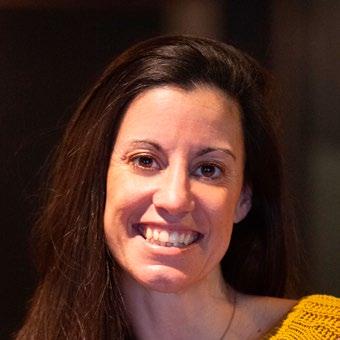
How do you get the best out of youth dancers in performance?
What are some techniques and strategies that work for you to raise standards and give space for young people to excel?
My pieces are always led by the young people – within the creative process we start with finding out what is important to them and what messages they like to share. We then move onto ‘world-building’ and asking/answering lots of questions –where are we, how did we get here, what’s here with us? That allows us to structure the ideas we have. Early in the process we use physical games to support dancers connecting and creating movement without placing too much emphasis on choreography. I like to get the young people ready for change – the idea of being able to shift ideas and adapt quickly is really important as it is a big part of the creative process, and often the performance space might be quite different to where you have been rehearsing.
Another area we focus on is stage presence, including embracing being still onstage. A great task is to get your performers to be still for one minute,
without dropping their projection –not as easy as it sounds! We do this regularly with everyone, whether they are seven or 70!
Building confidence in young people is key; it is all about constant reassurance. I always see the individual – spotting that small moment of success or contribution and mentioning it can go a long way. Ultimately this is what brings young people out of themselves, a bit like petals opening on a flower. They might open and close multiple times but as leaders if we praise and celebrate the great work that’s happening in front of us, and give guidance no matter how big or small, eventually that flower will bloom.
As your work grows and evolves, how can you measure your reach and impact and share with audiences and stakeholders?
As a company we use a variety of different ways to do this. With intensive projects, we often capture information at three points - before, during and after. This helps us in many ways; understanding what young people want to gain and what
skills they want to develop from the project, considering that against the skills we would like to develop and then charting that change in young people as they complete the project.
So much of our project feedback is done by video capture – in rehearsal, in the studio, or grabbing quick soundbites of young people talking about their experience. It doesn’t need to be the whole group giving you an evaluation in every situation, it works better to grab different parts of the story at different points.
The approaches we use to measure the impact vary depending on the type of project. We did a project in one school that was focused on attainment and achievement, and it was essential for us to gather hard, quantitative data to demonstrate whether their attendance improved as a direct result of the project.
Visibility of experience is really important. We know that journeys young people take can be transformational, and hearing the young people talk about what it takes to create a work and what it means to them is key.
34 The One Dance UK Magazine | Spring 2024 Special Focus on Sustainability
Zoie Golding
Photo: Sally Golden Photography
“For us, evaluation is at the heart of what we do. It is ongoing and helps drive our work forward and capture its impact for all involved.”

Can you share an example of a time you saw your work positively impact a young person or group of young people?
One example that comes to mind is I was brought in to work with four young men who had been excluded from school and were in the youth justice system on a week-long intensive project ending in a sharing of a piece we made. Halfway through the week behaviour was becoming challenging, so I made it clear that as a result I would be stopping the project that day. I had never done this before, but the outcome was surprising. The next morning, they were all at their houses ready to go on time and the three days afterwards became a dream!
One of the young men that same day fully pushed back against us all and I went to chat with him. Immediately I was met with “Why do you care? You’re just being paid to be here.” At that point, I was able to honestly say “I am here because I want to be here, I am really interested in what you’ve got to offer in this project.”
Even when as a leader you might feel like you are failing, it is about
perseverance and compassion. It’s fair to say that alongside working with young people there is a lot of emotional labour involved and this needs to be supported and considered constantly with team check-ins and outs.
Having had such a varied career in youth dance, how do you maintain motivation?
The young people I work with provide motivation. When I start a new project, I always ask the group lots of questions to get us started; what's interesting to you, what’s going on in your world at the moment, what story would you like to tell, what sort of mood would you like to create? This process brings ideas to me, and their responses usually generate more questions from me, keeping it exciting!
I've always had a theory that even if there's one person in the room willing to learn, I'll give them everything as this might be something that sparks their interest. I love to see people achieve things they didn’t think possible. It’s important to determine what success
looks like for you, as it can look different for everyone.
What excites you about the next phase of your work?
A key area of my work is engaging males in dance and looking ahead I really want to evolve our male dance platform into a national celebration of male dance, bringing together all the people doing amazing work in male youth dance to provide more opportunities to connect and share our work, what it looks like in practice, and support others on their journey.
I am also troubled by the current position of dance in education and want to champion the important role dance can have in a young person’s life. It is life-changing, so within my work I continue to look at ways we can support, both in the local area and champion the power of dance nationally.
Further information zoielogic.co.uk
Zoie recently conducted an online CPD session sharing her learnings from her career in youth dance. Free for members. onedanceuk.org/member-dashboard/webinars
The One Dance UK Magazine | Spring 2024 35 Special Focus on Sustainability
Photo: Matt Bartram
Zoie Golding MBE leading a session with Headfunk Creative
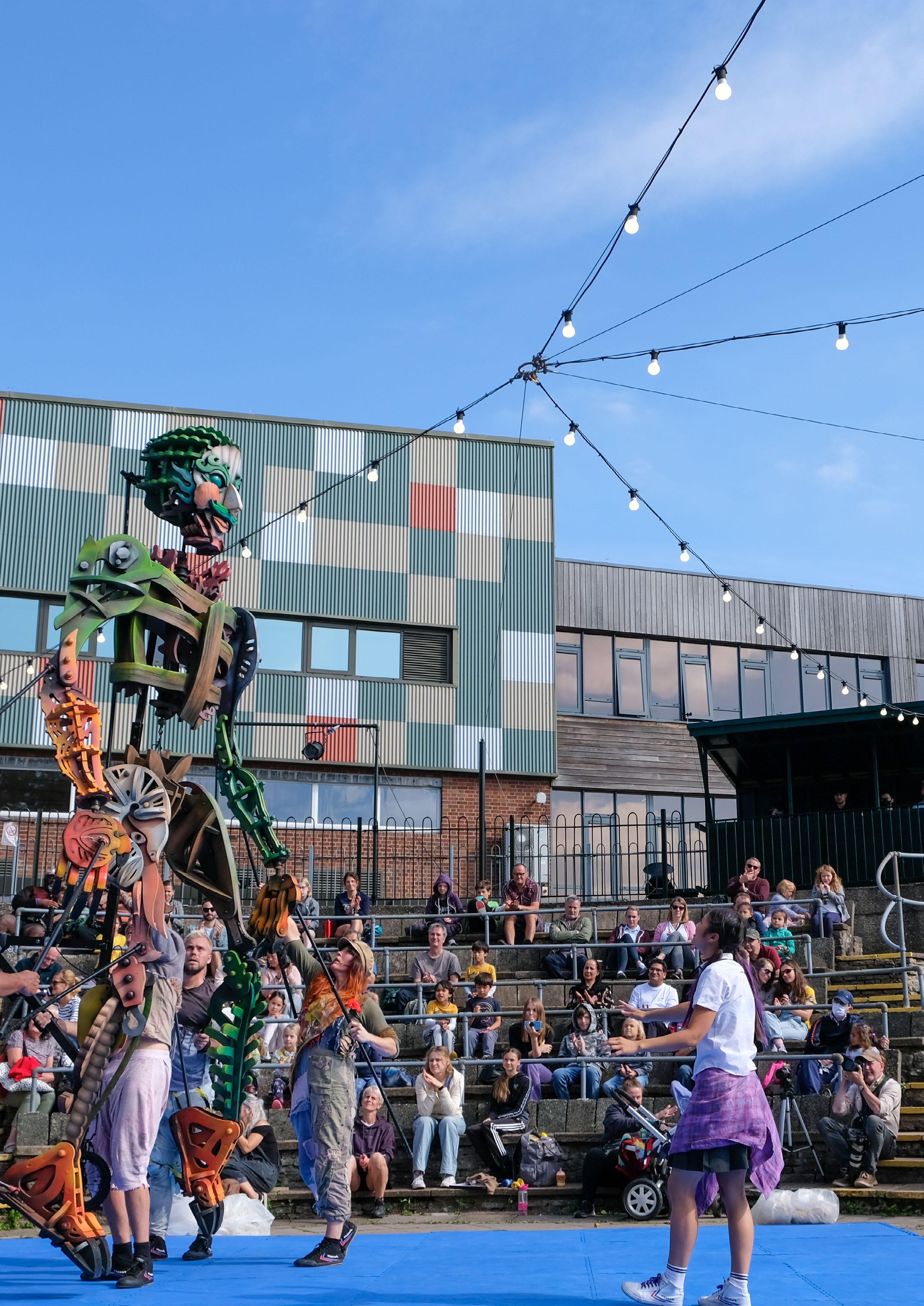
Building Dance Audiences
Sustaining an audience for dance in a multi-disciplinary venue takes commitment and support from management. We asked three directors of high profile venues how dance meets their programming aims.
Deborah Kermode from MAC, Birmingham, James MacKenzieBlackman from Theatre Royal, Plymouth, and Aaron Wright from London’s Southbank Centre share their thoughts.
36 The One Dance UK Magazine | Spring 2024 Special Focus on Sustainability
Deborah Kermode Chief Executive Officer and Artistic Director MAC, Birmingham

We can all agree that it has been a very challenging few years for dance companies and dancers, hit hard by the pandemic and the effects of the cost of living crisis. This has also had a profound effect on audiences’ behaviour towards attending live work, and the touring model remains precarious as venues respond to their new world situation.
When programming dance work across our venues, we ensure that it feels fresh, contemporary and has a unique point of view. MAC is committed to encouraging creative expression to flourish, and for audiences to be inspired by original work. Our programming choices always carefully consider the communities on our doorstep. Nurturing talent and offering free dance space for locally based dancers is crucial.
Of all the art forms we support, we receive the most requests from dance companies, whether using our studios or seeking advice for funding applications. Their boldness and ambition are important to us too, and we provide a safe space to ensure new work can flourish. Audiences also need to be aware of that journey, and to that end, we welcome dance work into our foyers and public spaces to alert the public to new possibilities. For example, our Associate Artist Autin Dance Theatre has captured huge amounts public attention
through large-scale ambitious projects that pop up across our venue spaces and spill out into Cannon Hill Park.
To sustain our dance audiences, we have taken time to understand new booking habits. We’ve noticed an increase in last minute ticket sales, and less ‘risk-taking’. We’ve found the best way we can retain our existing audiences is to programme work that speaks to them.
Luckily for us, MAC is based in a wonderfully multicultural city. Birmingham is richly diverse; a melting-pot of different cultures and experiences. Keeping the programme varied is helping us to build a stronger audience base – whether the work celebrates annual festivals or religious holidays such as Deepavali with Jaivant Patel Company. After four successful years, our dance audiences are much more reflective of our local communities, and we welcome diverse audiences to join in enjoying dance in all its nuances.
In 2023, we partnered with Motionhouse for a pioneering Christmas show, introducing younger audiences to physical dance. This was a particularly striking decision for us to programme dance for a festive season – something both organisations had never done before. Whether dance provides an escape, champions accessibility, such as wheelchair dance, or engages with global topics for our generation such as the climate crisis, the most
important thing for us as an arts charity is that the work speaks to our communities. Sometimes we don’t specifically focus on the idea of contemporary dance, rather we let the imaginations of our audiences focus on the strong storytelling and physicality of the work and promote on those terms.
“Dance
companies we partner with bring in loyal audiences, and emerging artists can push the boundaries of more traditional dance spheres and invite new generations into theatres.”
Deborah Kermode
Dance companies are also dance audiences; dancers experiencing work by their peers helps to energise the sector. Understanding this is key to developing and sustaining dance audiences. Above all, we ensure the dance work we programme tells stories from and with our communities; it must be relevant.
Further Information
MAC Birmingham: macbirmingham.co.uk/whats-on
The One Dance UK Magazine | Spring 2024 37 Special Focus on Sustainability
Photos: Autin Dance Theatre's 'Out of the Deep Blue' MAC Birmingham, 2021, Kate Green & Photo Courtesy Mac Birmingham
“Going
above and beyond visiting work, we are moving towards more producing of our own to ensure that dance continues to appeal to the widest possible audience, from musical lovers, drama enthusiasts, to infrequent theatregoers.”
James MacKenzie-Blackman
 James MacKenzie-Blackman Chief Executive Officer and Executive Producer, Theatre Royal Plymouth
James MacKenzie-Blackman Chief Executive Officer and Executive Producer, Theatre Royal Plymouth
We’re incredibly lucky to have a very loyal audience for dance at Theatre Royal Plymouth (TRP). This audience has grown over the last twenty years due to the regularity of visits from Birmingham Royal Ballet (twice a year) and Matthew Bourne’s New Adventures who tech, dress and open their shows in Plymouth every November, and have done so for thirty years.
In the last decade these regular seasons have been complemented by twice yearly seasons of large-scale international dance delivered to us through Dance Consortium. These presentations have gained popularity and we can now deliver an audience of up to 3,000 patrons across three shows. Alongside this, programming Rambert and Hofesh Shechter Company and more cross-artform companies like Frantic Assembly
means our large-scale dance programme is in very good shape.
Since I joined TRP in January 2022, we have started programming dance in The Drum, our studio theatre, to create opportunities for small and mid-scale companies to perform here. We have been in a fortunate position to be growing our dance audiences ‘down’ in the sense that, until recently, all the dance at TRP was on the large scale. Companies like James Wilton Dance are selling out in The Drum and generating new audiences for the artform which is really good to see.
Going above and beyond visiting work, we are moving towards more producing of our own to ensure that dance continues to appeal to the widest possible audience, from musical lovers, drama enthusiasts, to infrequent theatregoers.
Last year, we announced our co-

production of the world premiere stage production of Michel Hazanavicius’ multi–Academy Award-winning film The Artist. Premiering at TRP in May, The Artist is choreographed by Drew McOnie and features former Principal of New York City Ballet, Robbie Fairchild and musicals star Gary Wilmot, alongside some of the UK’s most promising dance talent.
All of us at TRP are immensely proud to be co-producing and launching The Artist here in Plymouth and look forward to welcoming people from all walks of life to appreciate this enchanting show, which has dance at its heart.
Further Information
Theatre Royal Plymouth: theatreroyal.com/whats-on
Tickets to The Artist, premiering May 2024: theatreroyal.com/whats-on/the-artist
38 The One Dance UK Magazine | Spring 2024 Special Focus on Sustainability
Photos: Pip & Steve Haywood
The Artist, produced by Theatre Royal Plymouth
Aaron Wright Head of Performance and Dance
Southbank Centre
The first dance production I saw was Matthew Bourne’s The Car Man at Birmingham Hippodrome. I had never thought that dance was for me, but in the years that followed, I found myself attending dance performances more frequently due to the accessible tickets on offer at venues such as Sadler's Wells. These unique experiences made me think about how we can open up the doors to those who have never had the opportunity to see a live production before.
The Southbank Centre is for everyone; welcoming, inclusive and relevant to all. We want to cultivate new audiences for performance and dance. We welcomed scores of new audiences through the Tuff Nutt Jazz Club doors to see a reimagined version of Nutcracker. Our current season draws heavily on pop culture with shows including (La) Horde’s Roommates with Ballet national de Marseille. The collective has gained a large following through their work with the likes of Madonna and Sam Smith, with swathes of new audiences
clamouring for tickets across France. This spring we welcome Hofesh Shechter: From England with Love Performed by Shechter II, the next generation of dance talent, the piece is a paean to the multi-layered complexity that is England.
London is a hugely diverse city with 46% of its residents being from global-majority backgrounds, and so we have a programming policy that is reflective of the demographics of London. My mission is to create a multi-faceted programme that speaks to both a breadth of underrepresented communities in the city, as well as international companies across the globe, in particular those who have never had the opportunity to showcase their work on a London stage.
We had the choreographer Alice Ripoll and her company Cia Suave from Rio de Janeiro perform with their production Zona Franca. We invited Portuguese and Brazilian community groups from Lambeth to watch the show - the atmosphere was electric, I’ve never heard an audience make so much noise! If we can showcase more work like this, we can unlock a whole
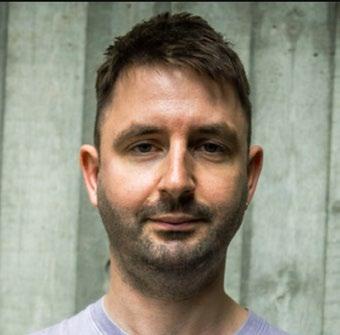
new wave of audiences which will enable us to sustain the art form for the next 20 years.
A key focus is to deliver a range of free, intergenerational performances, and participatory workshops for the next wave of upcoming artists and family shows for all. Everyone should be given the chance to access creative experiences. Over 40% of our events across the Southbank Centre site are free.
We’re working on ideas to extend our digital strategy across all artforms, with our Artistic Director Mark Ball. Instagram is an innovative and impactful platform to showcase dance. With the advent of TikTok, there is a range of dance content that audiences can access but I ask the question: why would audiences want to get up and leave their house to come and see the same piece of work live on stage? This is an exciting challenge that we are keen to embrace.
Further Information
Southbank Centre: southbankcentre.co.uk/whats-on

“We need to think about the different strategic ways we can sustain a flow of new audiences to dance.”
The One Dance UK Magazine | Spring 2024 39 Special Focus on Sustainability
Photos: Pete Woodhead & Todd MacDonald
Aaron Wright
Hofesh Schecter Company's From England with Love
Wellbeing for Dancers
Dance psychology researcher, lecturer and Founder of Dance in Mind Imogen Aujla PhD Dip. CBT shares some tools to help you improve your wellbeing in an accessible, systematic way.

Wellbeing is a complex concept. It can often feel like there is an overwhelming amount of information and advice about wellbeing, and it can be hard to know where to start. This article offers three strategies to improve wellbeing systematically, using the cognitive diamond. The cognitive diamond is based on cognitive behavioural therapy (CBT) models and forms an important component of my applied work and psychological coaching practice. One of the fundamental principles of CBT is that feelings are not caused by an event or situation in and of itself, but by our interpretations of that event or situation. These interpretations (thoughts) influence how we feel, our physical symptoms, and our behaviour – and these in turn can affect our thoughts; each component is interlinked.
Think about how you’ve been feeling recently, or recurrent feelings you struggle with, such as anxiety, low mood, stress, or anger. Try filling in a cognitive diamond to help you distinguish between different symptoms. This then provides a guide for what to start working on: behaviour, physical symptoms, or thoughts. I haven’t included feelings here, because remember that our feelings are often caused by our thoughts, behaviour, and physical symptoms. Addressing those other factors can change the way we feel.

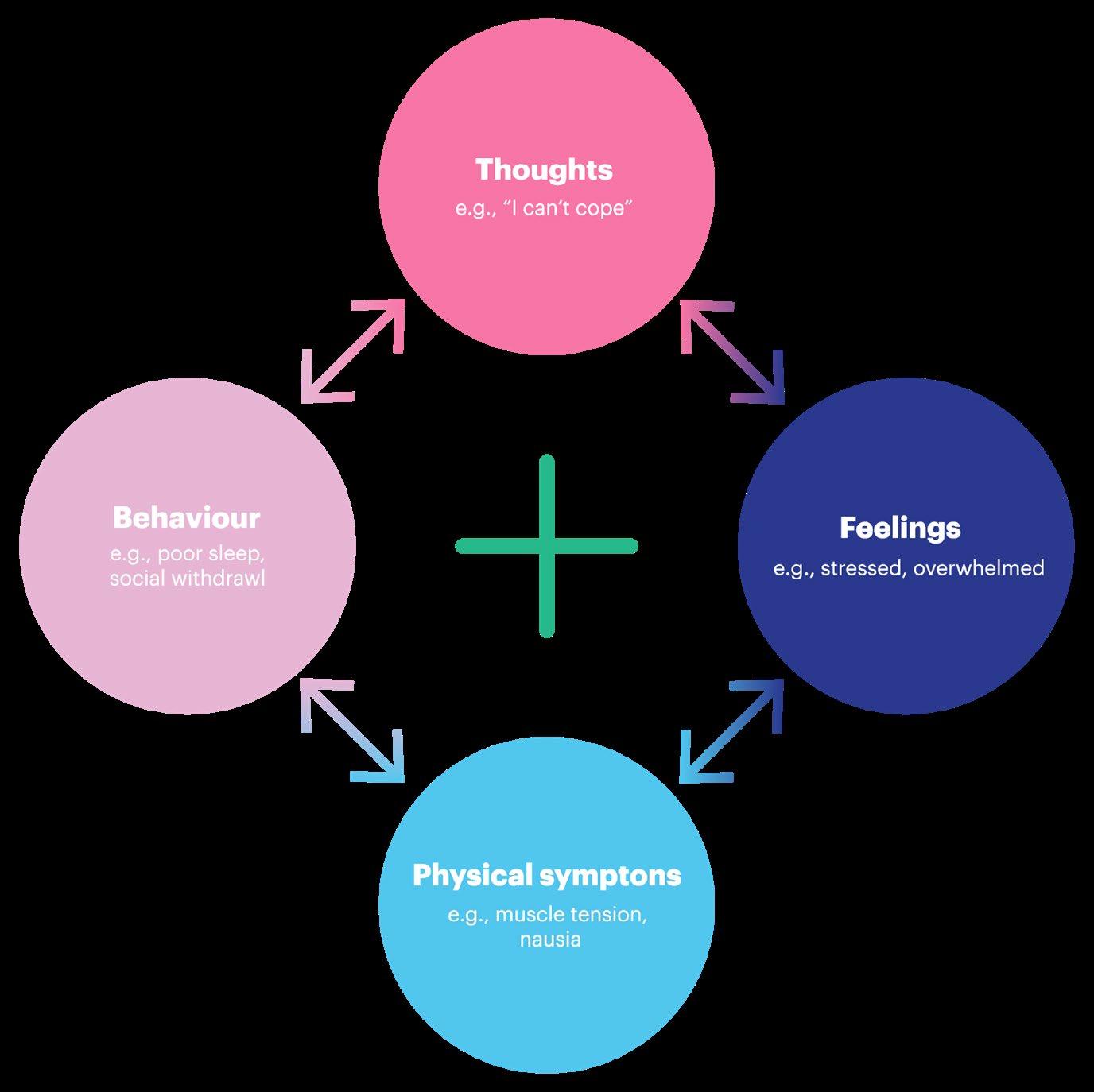
40 The One Dance UK Magazine | Spring 2024 Special Focus on Sustainability
The Cognitive Diamond
Photos: I. Aujla & Dani Bower for One Dance UK
Dr Imogen Aujla
Carden Stapleton
“Change takes time - it's a marathon, not a sprint.”

So how do we do it? Here’s a quick guide.
1. Change behaviour through activity scheduling
Activity scheduling can be really effective because it’s easy to do, has an immediate impact, and gives us the motivation to keep working on our wellbeing. Essentially, activity scheduling means making time for things you enjoy. Often our days are filled with work, chores and other responsibilities, and then we collapse in front of the TV or in bed, exhausted. Wouldn’t it be nice to find at least 10 minutes every day to dedicate to ourselves?
Activities where we can get really absorbed in what we’re doing (‘flow’ activities) work best, like crafting, painting, or learning something new. They provide a respite from intense feelings and help us to put things into perspective. These activities need to be regular – a one-off spa day is great, but smaller and more frequent activities are far more effective. Make sure you schedule them in your diary or calendar, as this will make you much more likely to do them!
2. Address physical symptoms
Different physical symptoms are associated with different difficulties, but they all tend to respond to movement very well. Movement can literally take the
edge off physical symptoms by regulating breathing and heart rate, releasing tension, and producing the “happy hormone” serotonin. Try a short sharp burst, such as star jumps or burpees, or something slower and lower intensity like yoga or tai chi.
Even deep breathing is very effective, and is a good option if you’re injured or are physically exhausted. Aim to lengthen the outbreath because this activates the parasympathetic nervous system, which enables our bodies to recover and conserve energy. You could also try relaxation, such as taking a hot bath, guided meditation, or being in nature. Handily, you can then schedule these activities to help with the behaviour component of the cognitive diamond!
3. Challenge unhelpful thinking styles
Recall that according to CBT, our feelings are not caused by an event or situation in and of itself, but by our thoughts: interpretations, judgements and evaluations of that event or situation. However, our thoughts are often automatic – we don’t always notice them – so we first need to become more aware of our thoughts, especially when they aren’t really serving us.
Next, we need to challenge them: evaluate the evidence for and against a thought we have had about a particular event. We can then use this evidence to create a more balanced, realistic thought about that event. Using thought diaries is a helpful technique for this because thought diaries encourage systematic evaluations of thoughts and ways to practice challenging them. You can find a free downloadable thought diary at www.danceinmind.org.
Making a start
If you’ve completed a cognitive diamond, write down some ideas to help you address behaviour, physical symptoms, and thoughts. Only work on one area of the diamond at a time, then move on to the next; working on all three areas at once can lead to overwhelm. Change takes time – it’s a marathon, not a sprint. These skills and strategies can be applied throughout your life in a variety of situations, so it’s worth taking your time to find out what works best for you. Give it a go and see where it takes you!
Further information danceinmind.org danceinmind.org/courses danceinmind.org/worksheets-and-factsheets
The One Dance UK Magazine | Spring 2024 41 Special Focus on Sustainability
Photo: Linden Youth, Dani Bower for One Dance UK
Sustainability, Racism and Me
By Stacey Green, Co-Founder of
The TIRED Movement, which works to drive change to improve accessibility and inclusivity in dance education.
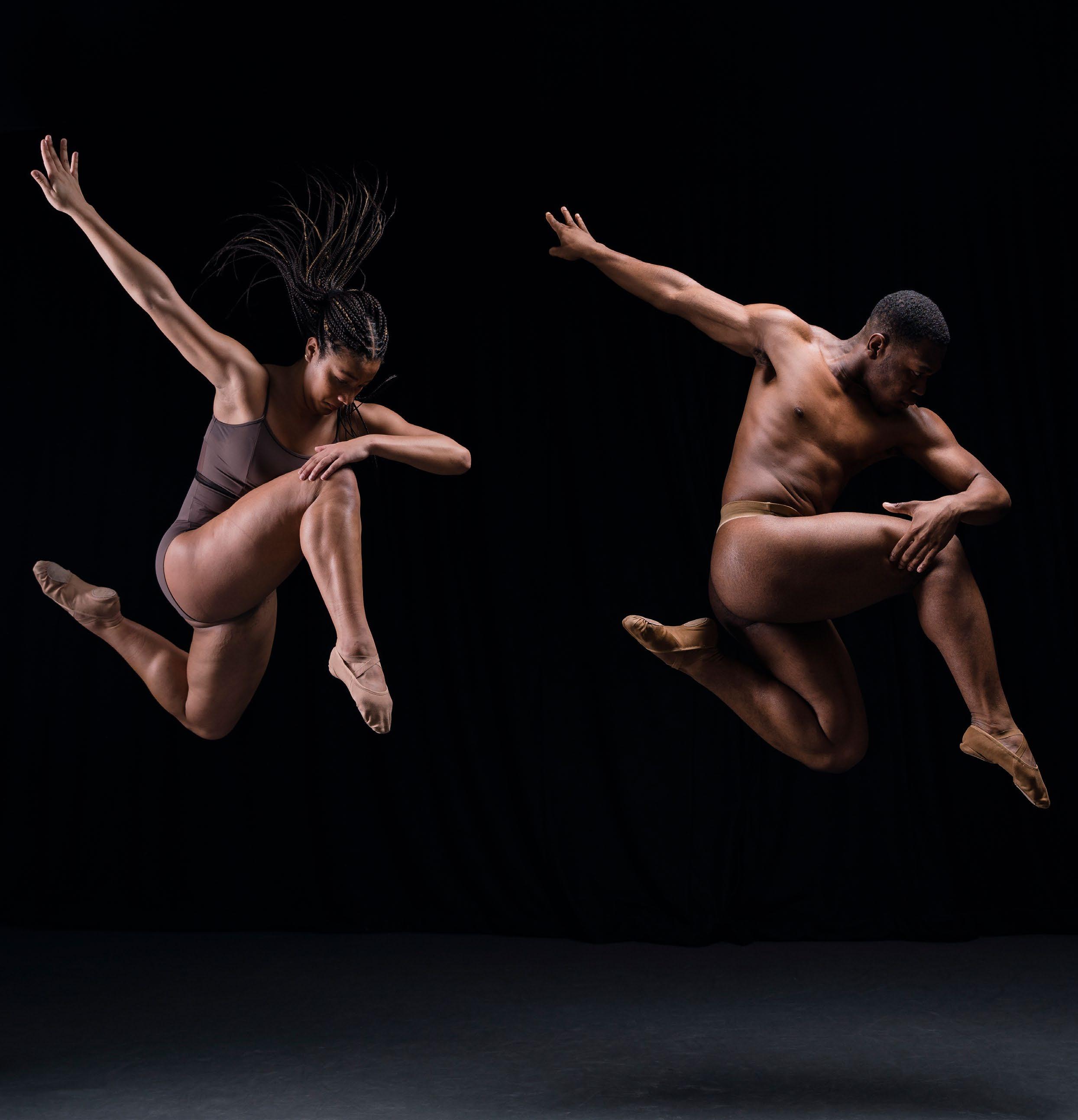
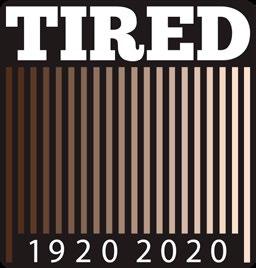
42 The One Dance UK Magazine | Spring 2024 Special Focus on Sustainability

Stacey Green
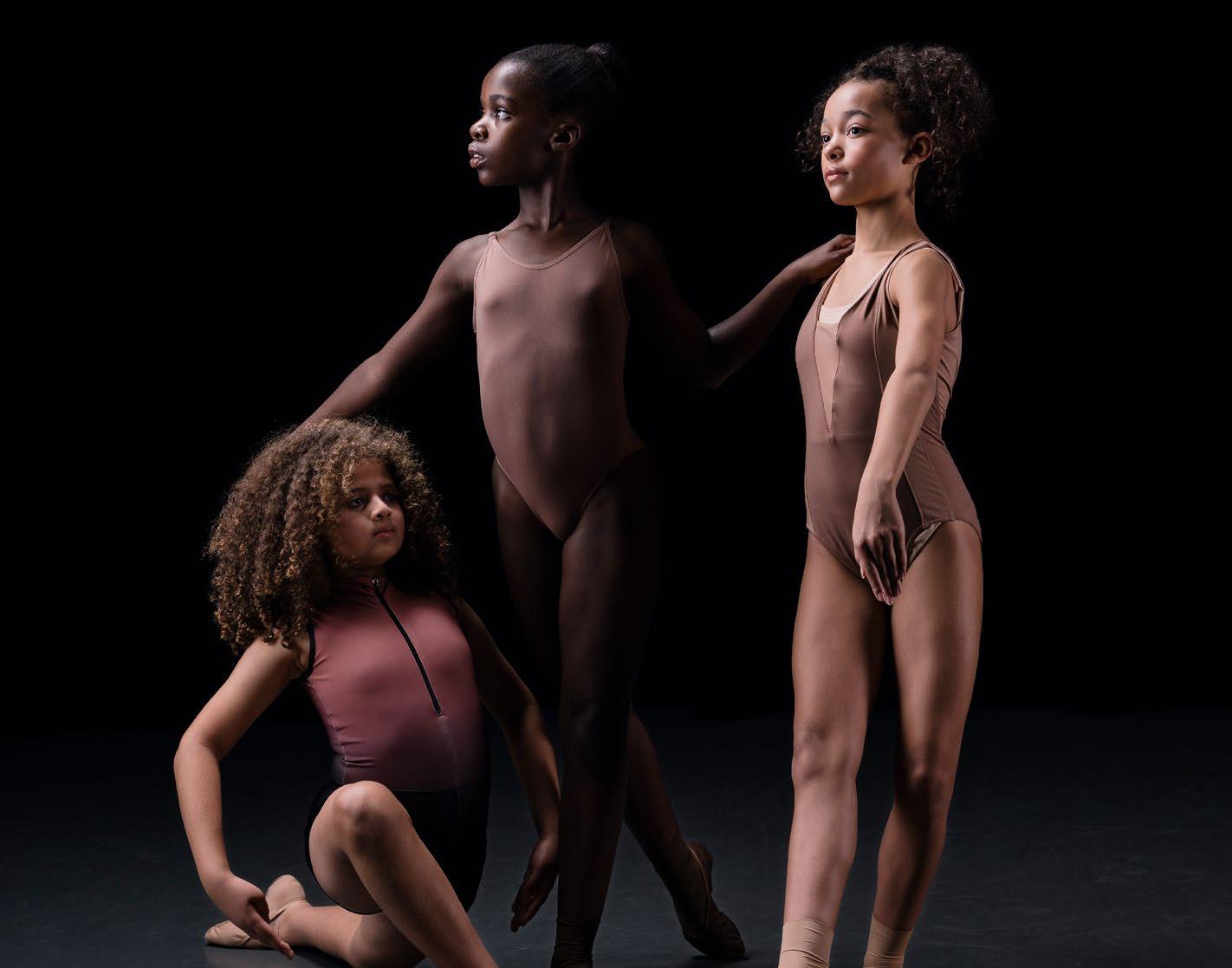
As dance educators and leaders, it is vital that we appreciate the importance of paying respect to the pioneers of dance, and the history of each genre. Recognising the similes between racism and the deterioration of the planet ensures that good practice is adhered to within our work.
There have long been feelings of superiority and greed when creating choreography for our audiences. Without real research there is no authenticity.
“Taking or‘borrowing’
from another culture is a regular occurrence, and appropriation typically goes unnoticed. But how do we keep driving for change, without fully understanding the lessons that need to be learned?”
Just like destructive histories of colonisation, where people of colour have historically seen their home countries stripped of their native resources, global climate change is a threat to us all. People of colour have
paid a high price for the destruction of their environment, led by greed and the capitalist aims of the global north. This can be likened to the stealing of dance styles for individual gain.
Profiting off minoritised cultures is theft, plain and simple.
Often, when referring to the global majority, the language used highlights societies’ perception of privilege. Saying things like “they/them/ those” when describing dancers of colour implies that outsiders are not welcomed or included in majority white spaces. This sends a powerful message about who is really valued in our industry and who is not.
As members of the dance community and supporters of the arts, it is up to us to advocate for change.
So, what can I do?
1. You don’t need to be an expert in all genres of dance, but you do need to be open to continually learning about dance styles’ history
2. Don’t teach styles that you have learned on TikTok or Instagram without context. Just because a choreographer has thousands of followers, doesn’t mean that their choreography is authentic
3. Make sure you are the right person to teach certain styles and have the knowledge and
experience to deliver good practice. If not, there are plenty of incredible artists out there who would love the chance to work with you
4. Don’t shy away from experimental choreography, but do be mindful of the message you want to share and the audience you want to engage
5. Be proactive and ask questions. Don’t be reactive and simply follow the trends
Why does this affect me?
You are affected because people of all backgrounds and ethnicities must unite to help preserve and restore our environment. Working to save the planet, like standing up against racism within our industry, can best be achieved by engaging a diverse community who want to create sustainable life with respect for all. Dismantling racism in dance means dismantling the pyramid of power that is present within our industry. We can only do this by coming together and working towards a unified voice to collectively bring about change. Because... “The more voices we hear, the louder we become.”
The One Dance UK Magazine | Spring 2024 43 Special Focus on Sustainability Further Information tiredmovement.com
Photos: Drew Forsyth
Connect, Share, Upskill
You may have seen that One Dance UK has a brand new website! It’s got a fresh look and is full of interactive features to allow you to make the most of your membership and connect with the latest from the dance sector. Check it out at www.onedanceuk.org
We have a range of opportunities coming up this year for you to take part in. We look forward to connecting with you soon!
Young Creatives
Young Creatives is a unique two-year programme for developing the next generation of aspiring choreographers with 2024 lead artists Sarah Dowling and Rhian Robbins and Creative Assistant Liam Francis. Year 2 participants will be mentored by industry professionals such as Kate Flatt OBE, Vidya Patel and JohnWilliam Watson to create work for live performance in July 2024.
bit.ly/YoungCreatives1
Young Creatives 2024 Programme Associate: London Contemporary Dance School and The Place
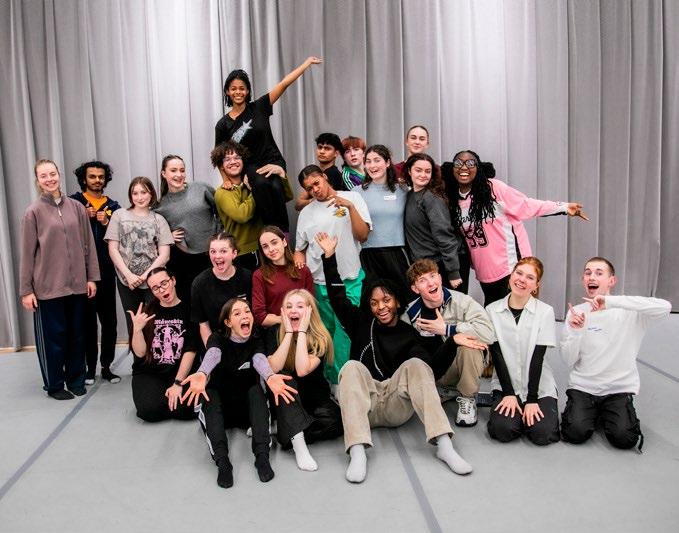
Funding Surgery Sessions
Want to upskill and improve your chances of funding success? Alisha Kadri, Head of Membership and Business Development at One Dance UK, is offering slots for members to get in touch to talk about funding. The funding surgeries are in 30-minute slots but can be 1 hour if needed.
info@onedanceuk.org

CPD Snippets
One Dance UK has designed a CPD programme that is easily accessible to all members. Each recording is approximately 15 minutes in length and is designed so you can dip in and out.
bit.ly/CPDSnippets-Teachers
Member Webinars
Tune in to watch experts from across the dance sector share ideas, advice and case studies to enhance your work or learning. Covering areas of work such as health and wellbeing, children and young people’s dance and fundraising, our growing library has lots of useful content.
bit.ly/OneDanceUKWebinars
Free Safeguarding Training
One Dance UK is partnering with Safer Dance and High Speed Training to offer FREE safeguarding training for the dance sector. High Speed Training has helped thousands of individuals and organisations learn about effective safeguarding practices, from the basics of child protection to supporting adults with learning disabilities. This online safeguarding course was built with sector specialists to deliver the latest guidance and industry thinking.
bit.ly/DanceSafeguarding

Photos from left to right: Overdrive, Momentum Boys at U.Dance National Festival 2023, Young Creatives 2024, Janice Ho, Linden Dance all by Dani Bower. 44 The One Dance UK Magazine | Spring 2024 Special Focus on Sustainability
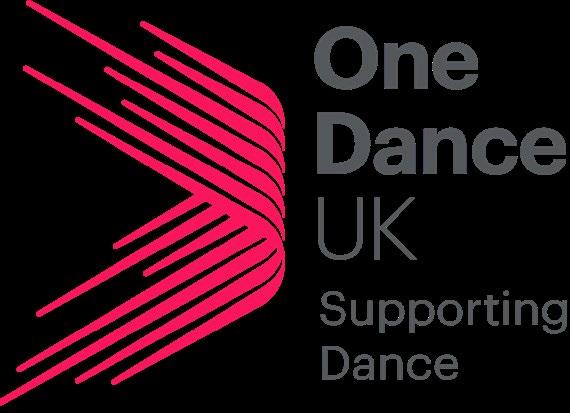
New Health and Wellbeing add-on
One Dance UK members will soon be able to access an exciting new Health & Wellbeing add-on which will give access to financial and legal advice, virtual GP appointments same day, next day prescriptions, and an extensive range of mental health support including online resources, counselling, treatment and complex case management. Coming soon!
Healthcare Practitioners Directory
One Dance UK’s Healthcare Practitioners Directory is a free searchable online database listing details of medical, psychological, and complementary health practitioners throughout the UK. All the individuals on the directory have experience of working with dancers and have been recommended by members of the dance profession.
onedanceuk.org/health-practitionersdirectory

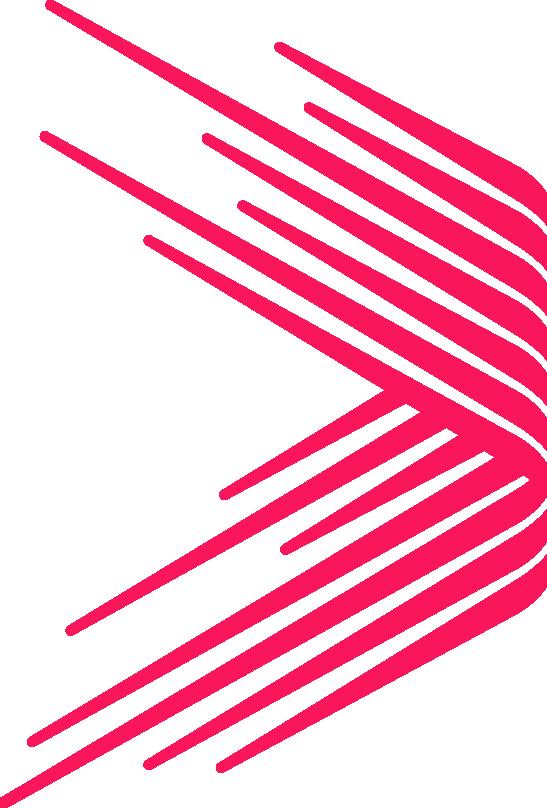
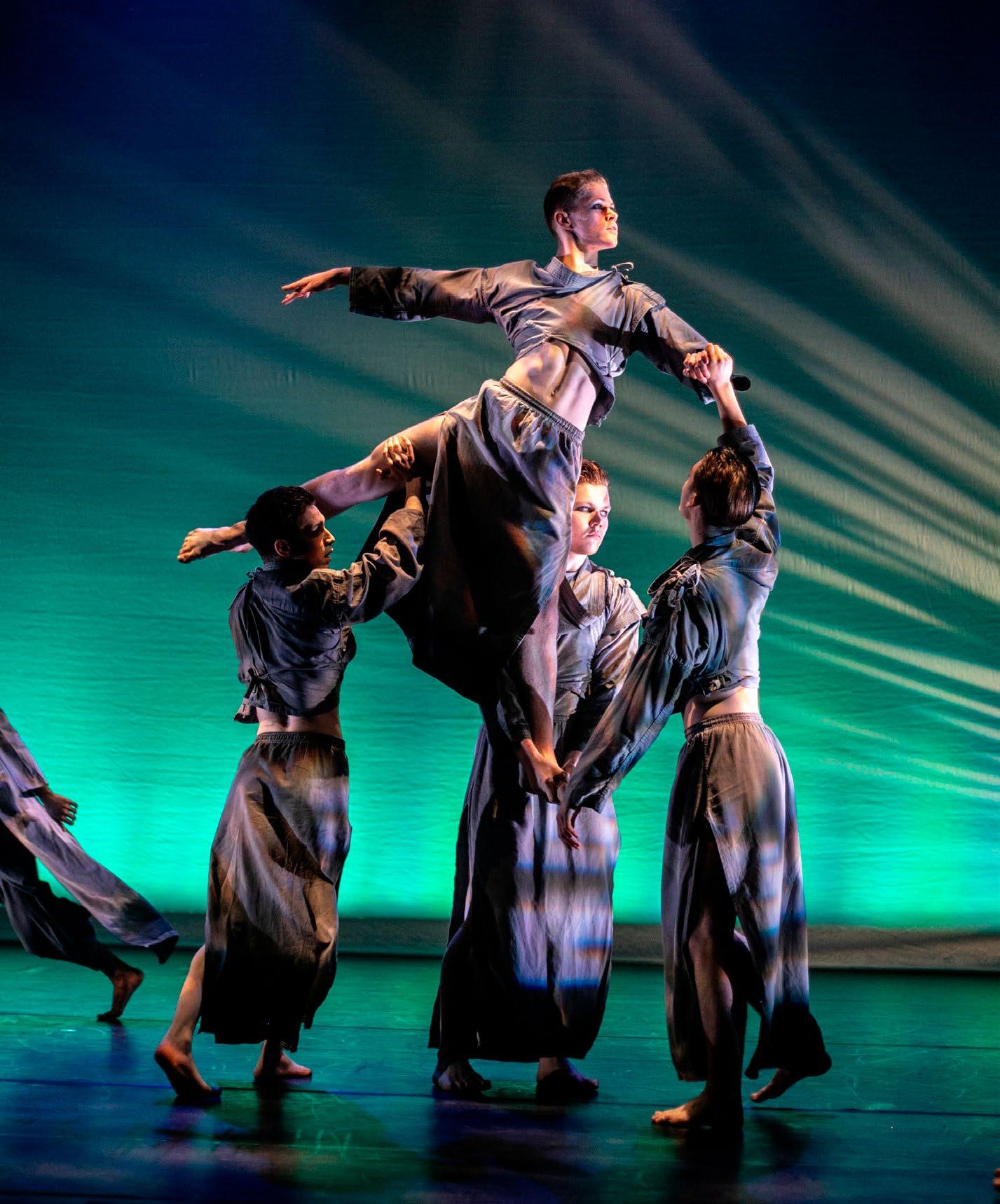
U.Dance First
U.Dance first aims to address the lack of high-quality noncompetitive performance opportunities for primaryaged children. We work with hosts and partners to support platforms by offering resources and certificates, CPD for teachers, assistance at events and marketing and promotional support.
onedanceuk.org/programmes/udance
U.Dance National Festival 2024
The U.Dance National Festival 2024 will be held 13-14 July in Liverpool in partnership with Liverpool Playhouse, LIPA and LMA. Hundreds of young dancers from around the country will perform, learn and connect at this incredible celebration of youth dance. A special U.Dance on Screen event will also be held at BFI London Southbank.
onedanceuk.org/programmes/udance
The One Dance UK Magazine | Spring 2024 45 Special Focus on Sustainability

Celebrating the next generation U.Dance
One Dance UK is committed to supporting high-quality, lowcost opportunities for young dancers. U.Dance is the national programme of events offering exciting dance experiences to young people. Each year, our nation’s young dancers can experience the thrill and sense of achievement of performing! See below the three strands of the U.Dance and get in touch to find out more.
onedanceuk.org/programmes/udance u.dance@onedanceuk.org

U.Dance First platforms are performances presenting dance work featuring children and young people from more than one school or group aged 5-11, in communities up and down the UK.This new strand places emphasis on providing performance opportunities for primary-aged children, helping to address the current lack of specific dance provision and high-quality non-competitive platforms for younger children.

U.Dance Regional Platforms, which take place across the UK, offer exciting performance and workshop opportunities to thousands of dancers aged 11+ each year. Regional Platforms are hosted by a network of partner organisations and take place each spring, showcasing the talents of the region’s young dancers.They take place in the spring each year and form part of the selection process for the U.Dance National Festival.

The largest event of its kind, the U.Dance National Festival is a celebration of youth dance every summer. Groups of young dancers from around the country, drawn predominantly from U.Dance Regional Platforms, perform on professional stages, take part in workshops with leading dance professionals, and are offered inspiring dance careers information.
The U.Dance National Festival 2024 will be held in Liverpool on 13-14 July!
Further Learning
One Dance UK offers all children and young people, and those who work with them, extensive resources and guidance on further developing their dance training and knowledge.
A Dance Careers Hub,A Guide to Careers in Dance, links to youth talent development schemes and more are all available for free on our website.
Dani Bower
Photo:
U.Dance
46 The One Dance UK Magazine | Spring 2024

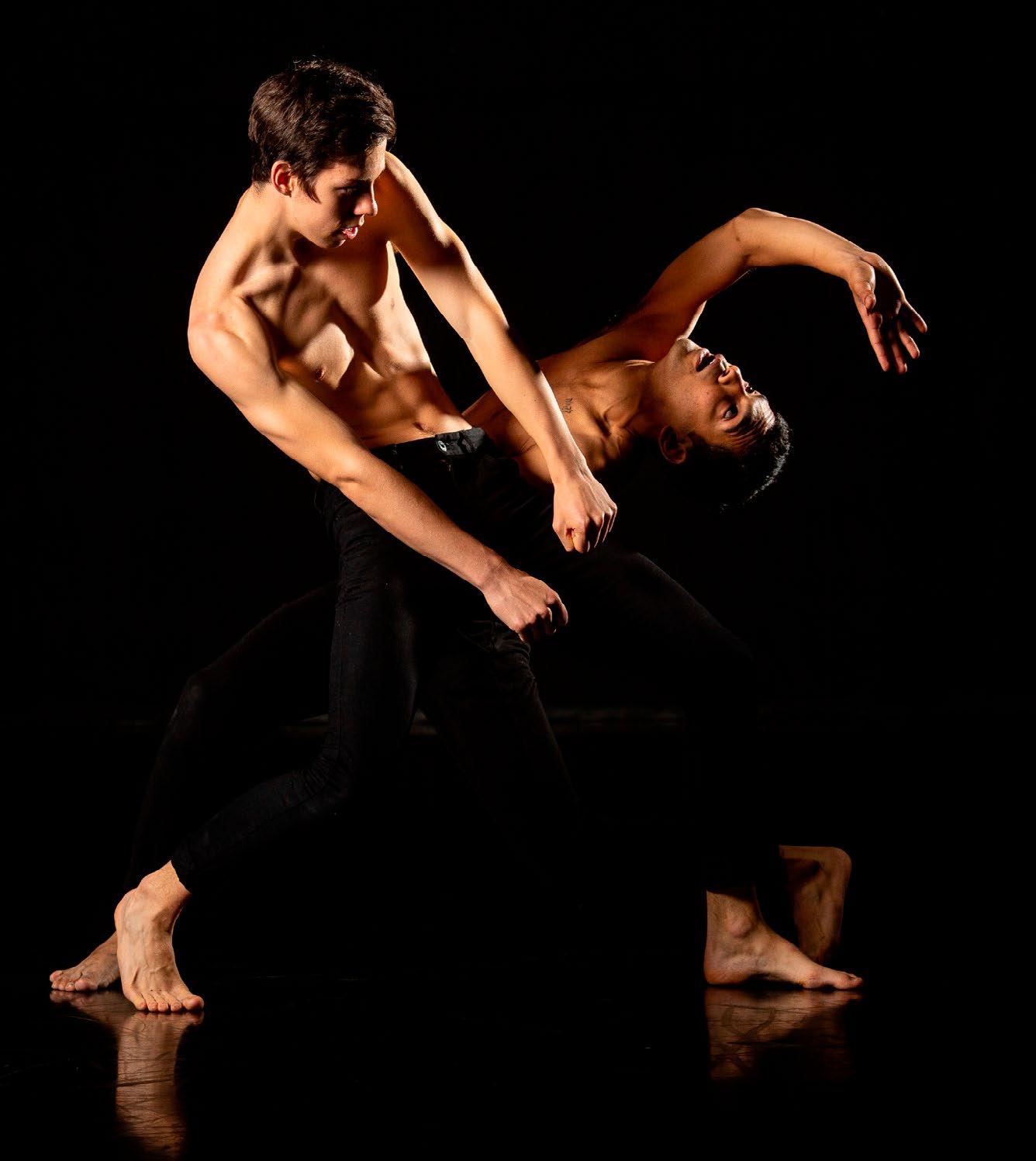
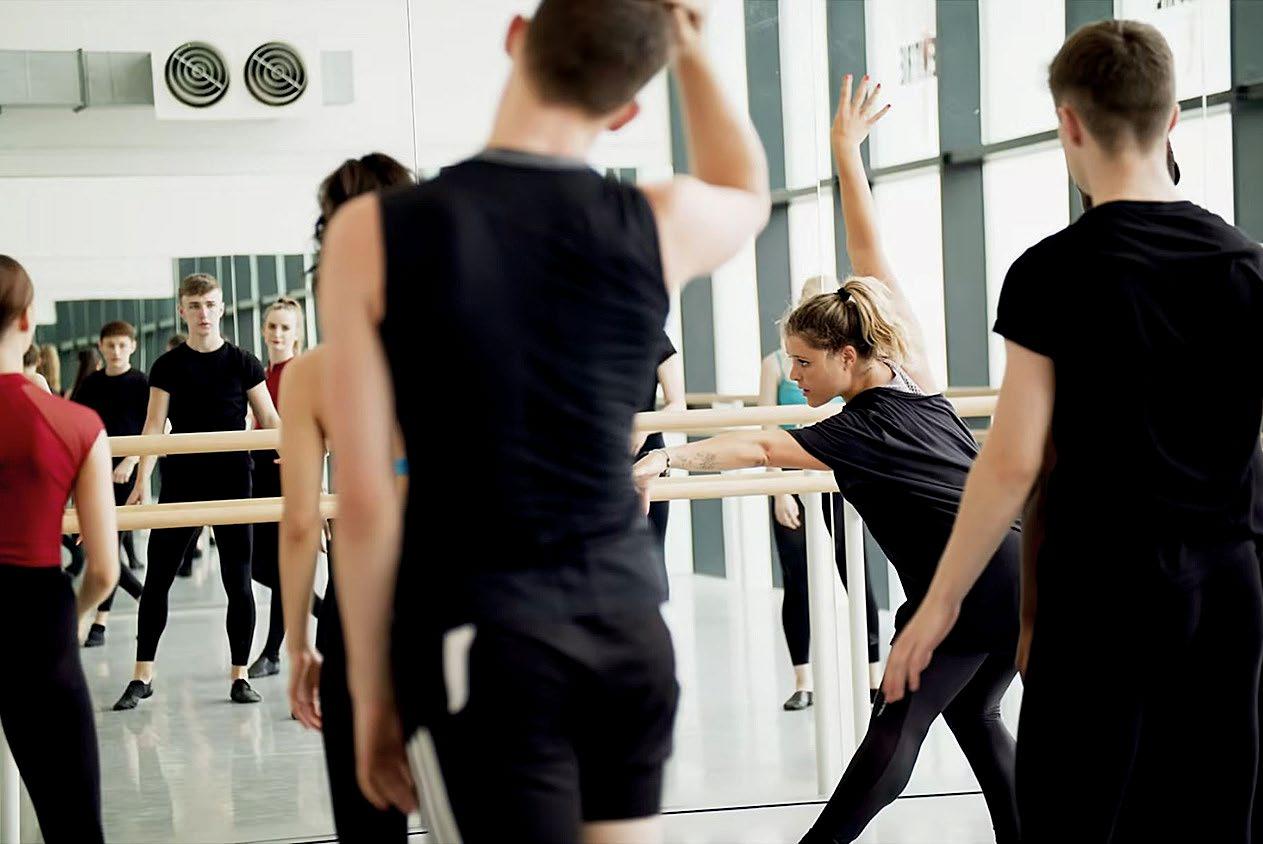


The One Dance UK Magazine | Spring 2024 47 @uoc_mmp BA Professional Dance and MA Dance chester.ac.uk/mmp Find your people Find your place Join us in September 2024 MA DANCE EDUCATION • Part-Time or Full-Time • Distance Learning and flexible timetable • Non-traditional entry requirements • No international fees A Professional Teaching qualification for working dance teachers who want to update their knowledge and fit their studies around their work. www.londonstudiocentre.org Find out more OneDanceUK-MADE-print-ad-Feb-24.indd 1 21/02/2024 15:08








 Andrew Hurst MBE Chief Executive, One Dance UK
Andrew Hurst MBE Chief Executive, One Dance UK


































































 James MacKenzie-Blackman Chief Executive Officer and Executive Producer, Theatre Royal Plymouth
James MacKenzie-Blackman Chief Executive Officer and Executive Producer, Theatre Royal Plymouth






























